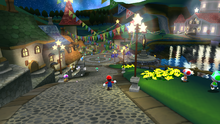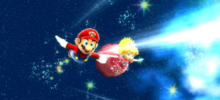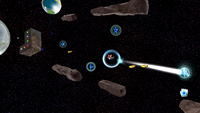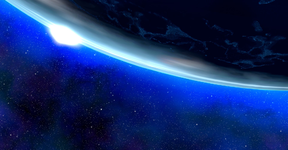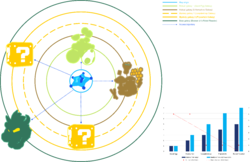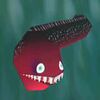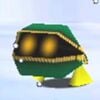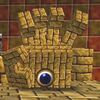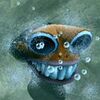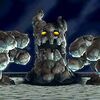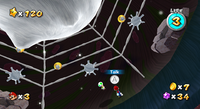Super Mario Galaxy
- "Mario Galaxy" redirects here. For the stage in Super Smash Bros. for Wii U and Super Smash Bros. Ultimate, see Mario Galaxy (stage).
- This article is about the game known as "Super Mario Wii" in Korean. For the game commonly referred to as "Super Mario Wii" in other languages, see New Super Mario Bros. Wii.
- Not to be confused with Super Galaxy.
| Super Mario Galaxy | |||||||||||||||||
|---|---|---|---|---|---|---|---|---|---|---|---|---|---|---|---|---|---|
 For alternate box art, see the game's gallery. | |||||||||||||||||
| Developer | Nintendo EAD Tokyo | ||||||||||||||||
| Publisher | Nintendo | ||||||||||||||||
| Platform(s) | Wii, Wii U, Nvidia Shield (Mainland China only)[1] | ||||||||||||||||
| Release date | Original release: Template:Release Nintendo Selects: Template:Release Wii U (digital download): Template:ReleaseNvidia Shield: Template:Release | ||||||||||||||||
| Language(s) | English (United Kingdom) English (United States) French (France) French (Canada) German Spanish (Spain) Spanish (Latin America) Italian Japanese Simplified Chinese1 Korean 1 - Exclusive to the Nvidia Shield version. | ||||||||||||||||
| Genre | Platformer, Action-adventure | ||||||||||||||||
| Rating(s) | Original release:
| ||||||||||||||||
| Mode(s) | Single-player Two-player co-op | ||||||||||||||||
| Input | Wii: Wii U:
| ||||||||||||||||
Super Mario Galaxy is a 3D action-adventure platformer game for the Wii, first released in Japan on November 1, 2007. It is the eleventh entry in the Super Mario series,[2] the third 3D platformer, and the first of what would be recognized – in retrospect – as the "course clear-style" games of the series.[3][4] It sees Mario traverse more linear levels than those found in its 3D predecessors – Super Mario 64 (1996) and Super Mario Sunshine (2002) – that largely consist of spherical platforms with their own centers of gravity. The plot has Mario exploring the cosmos and collecting Power Stars to rescue Princess Peach from Bowser, who is aiming to establish his own galaxy at the center of the universe. Mario is aided by his brother Luigi, a brigade of colorful Toads, star-shaped creatures called Lumas, and a mysterious woman named Rosalina. The save data description for the game is "Launch into a cosmic adventure!"
Super Mario Galaxy was critically acclaimed and commercially successful upon its release. It received various awards and accolades, including from the Academy of Interactive Arts & Sciences, the Interactive Achievement Awards, and the British Academy of Film and Television Arts. It has sold 12.80 million copies, making it the ninth best-selling Wii game.[5] It was re-released in 2011 under the Nintendo Selects branding for having sold so well. It is one of the few Wii titles to have been ported to the Nvidia Shield console in 2018. A port of the game with upscaled graphics was included in Super Mario 3D All-Stars alongside Super Mario 64 and Super Mario Sunshine on September 18, 2020 to correspond with the 35th anniversary of Super Mario Bros. (1985).[6] After its original release a dedicated sequel, Super Mario Galaxy 2, was developed and released for the Wii on May 22, 2010.
Super Mario Galaxy has gone on to be considered one of the greatest video games of all time and a masterpiece.[7][8][9][10]
Story
From the instruction booklet
Every hundred years, a huge comet flies by in the skies above the Mushroom Kingdom. One year, that comet filled the entire sky, and from it fell a stream of shooting stars. The Toads scooped up the Star Bits and brought them to the castle, where they were reborn as a great Power Star. It was a happy time in the Mushroom Kingdom. Then one night Mario received a letter...
Dear Mario, I'll be waiting for you at the castle on the night of the Star Festival. There's something I'd like to give you. From Peach
With invitation in hand, Mario headed off to the castle just as the Star Festival was getting into full swing. Surrounded by Toads gleefully trying to catch falling Star Bits, Mario was looking forward to the night's festivities.
But then, something happened...
Every century, on the eve of the Star Festival, a comet passes over the Mushroom Kingdom and causes magical stars and stardust to fall to the planet below. Peach invites Mario to her castle to join in the festivities and receive a special gift. As Mario arrives in the Castle Gardens, Bowser suddenly attacks the Toads with his airships and encases them in crystals. He "invites" Peach to the creation of his brand new galaxy and lifts the castle off the ground with a UFO to carry it to the center of the universe, taking her, two Toads, and Mario with it. Before Mario can reach Peach, Kamek appears and casts a spell at him, sending him into space. An apricot-colored Luma, whom Peach was carrying before her abduction, flees to look for Mario before Kamek warps the castle away with another spell.

Mario is awoken by the apricot-colored Luma on a small grassy planet. Here, he meets other Lumas and Rosalina, a mysterious woman who acts as the protector of the galaxies and the mother of the Lumas. She tells Mario that her ship, the Comet Observatory, had its Power Stars stolen by Bowser. Without them, the Comet Observatory is unable to move through space. Rosalina asks him to reclaim her Power Stars. In exchange, she offers to help rescue Peach and defeat Bowser. Rosalina gives him the apricot-colored Luma to help him on his quest. He grants Mario the ability to spin and travel through space. Together, they travel to various galaxies in opened domes to obtain Power Stars. Once a mission is completed in one galaxy, Mario collects a Power Star and unlocks the next mission. Most domes contain five galaxies. Once Mario has collected enough Power Stars, the next galaxy in the current dome is an enemy base where either Bowser or Bowser Jr. would be using the power of one of the Grand Stars, large varieties of Power Stars. Rescuing the Grand Star unlocks the next dome. When enough Power Stars are collected, the Comet Observatory takes Mario to the center of the universe.
Once there, Mario defeats Bowser in his brand new galaxy, retrieves the last Grand Star, and rescues Peach. Just then, a large sun in Bowser's near-complete galaxy undergoes a supernova and becomes a supermassive black hole which begins pulling in everything. The Lumas from the Comet Observatory, including the apricot-colored Luma, throw themselves into the black hole in order to neutralize it, and it soon evaporates in a massive explosion. Mario appears in front of Rosalina, who saves him from the cataclysm and tells him that this is not the end, but a new beginning for the universe, which repeats its cycle indefinitely, each time a little differently.
Mario later awakens in the Mushroom Kingdom near Peach's Castle. He sees characters and enemies he met throughout his adventure celebrating together. Bowser and Peach lie next to him and begin to stir. When he looks into the air, he notices a newborn galaxy as Rosalina's words echo in his mind, and exclaims, "Welcome! Welcome new galaxy!" The camera pans out into space, revealing the reconstructed universe. After 120 Power Stars have been collected, a special cutscene plays after the staff roll: Rosalina thanks the player and says, "I will watch over you from beyond the stars." before flying off with the Comet Observatory. Alone in the rubble left by the supermassive black hole, an apricot-colored Luma appears behind a decrepit starship. This alludes to the idea of how the universe repeats itself. The events of the past will carry out anew, with the lost apricot Luma searching for its mother.
Gameplay
Basic gameplay
Gameplay is somewhat different from the previous Mario titles, as rather than being played strictly in 2D or 3D, the game occasionally shifts from 3D to 2D and vice versa (although the core gameplay is largely in 3D); the game also utilizes sphere walking. Even with these changes, however, the gameplay heavily resembles Super Mario 64 and Super Mario Sunshine, with a similar camera system and similar gameplay mechanics.
Basic controls
The game has several innovations and additions to the basic 3D Mario game concept. Mario is controlled with the analog stick and can jump with the ![]() . The
. The ![]() works just as the
works just as the ![]() trigger did in Super Mario 64. The player uses it to make Mario crouch, do Backwards Somersaults, Side Somersaults, and Long Jumps. Mario can also Triple Jump by jumping with precise timing three times, each time jumping higher than before. The
trigger did in Super Mario 64. The player uses it to make Mario crouch, do Backwards Somersaults, Side Somersaults, and Long Jumps. Mario can also Triple Jump by jumping with precise timing three times, each time jumping higher than before. The ![]() centers the camera behind Mario, while the
centers the camera behind Mario, while the ![]() can adjust the camera angle manually. By pressing
can adjust the camera angle manually. By pressing ![]() , the player can enter a first-person perspective.
, the player can enter a first-person perspective.
The game also uses the motion sensors of the Wii Remote. The pointer of the Remote appears as the Star Cursor on the screen. The Star Cursor is used to perform a variety of actions, such as using Pull Stars, manipulating Sling Pods, and collecting Star Bits. Shaking the Wii Remote or Nunchuk makes Mario perform a spin.
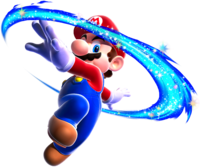
By pressing ![]() , players can fire a Star Bit. When enemies are hit by a Star Bit, they are stunned and can be defeated with a touch, releasing Star Bits. Mario can also defeat most enemies by jumping on them, which creates a coin Mario can use to heal HP. Using the spin to defeat enemies is also possible. Spinning may also stop an enemy from attacking; if Bowser and Mario both spin at the same time, both moves get canceled. Also, if Mario or Luigi Long Jumps then lands on the ground and quickly does a spin, they will do a small pirouette. The player can use any of these tactics to defeat regular enemies, though special enemies such as the Grand Goomba in the Gateway Galaxy might require a spin. Several enemies are, however, much easier to defeat by shooting them than by jumping on them. As in Super Mario Sunshine, Mario can jump on NPCs to gain extra height or annoy them.
, players can fire a Star Bit. When enemies are hit by a Star Bit, they are stunned and can be defeated with a touch, releasing Star Bits. Mario can also defeat most enemies by jumping on them, which creates a coin Mario can use to heal HP. Using the spin to defeat enemies is also possible. Spinning may also stop an enemy from attacking; if Bowser and Mario both spin at the same time, both moves get canceled. Also, if Mario or Luigi Long Jumps then lands on the ground and quickly does a spin, they will do a small pirouette. The player can use any of these tactics to defeat regular enemies, though special enemies such as the Grand Goomba in the Gateway Galaxy might require a spin. Several enemies are, however, much easier to defeat by shooting them than by jumping on them. As in Super Mario Sunshine, Mario can jump on NPCs to gain extra height or annoy them.
Swimming is fairly simple. Mario can change his direction by using the analog stick and can dive by pressing Z. Breaststrokes are possible by pressing ![]() repeatedly while swimming forward. Mario must return to the surface or collect air bubbles periodically in order to refill his air supply. Failure to do so could result in losing a life.
repeatedly while swimming forward. Mario must return to the surface or collect air bubbles periodically in order to refill his air supply. Failure to do so could result in losing a life.
Skating is a technique used when on ice. Mario merely needs to spin while walking, and he starts to skate.
There is also a move that is not explained in the instruction booklet. If the player, while airborne, both shakes the controller and presses ![]() (to spin and Ground Pound at the same time), they perform a special ground pound that homes in on nearby enemies. If there is no enemy nearby, Mario does a fancier ground pound. This move returns in the game's sequel, also unexplained in the packaged materials.
(to spin and Ground Pound at the same time), they perform a special ground pound that homes in on nearby enemies. If there is no enemy nearby, Mario does a fancier ground pound. This move returns in the game's sequel, also unexplained in the packaged materials.
Co-Star Mode
Featured in Super Mario Galaxy is a multiplayer mode called Co-Star Mode. By simply connecting a second Wii Remote, another player can join in and assist the first player by controlling a second Star Cursor, and in doing so can accomplish a variety of different things, some of which the first player can do, but many of which the first player cannot do. When Co-Star Mode is active, "1P" appears below Player 1's Star Cursor, and "2P" appears below Player 2's Star Cursor to help differentiate between them. When Co-Star Mode is not in use, these indicators no longer appear beneath either player's Star Cursors, until such time as Co-Star Mode becomes active again. The second player can collect Star Bits and fire them at enemies to briefly stun them. When the second Star Cursor is pointed at Mario and ![]() is pressed, the second player can make Mario perform a Co-Star Super Jump. Combining both jump techniques can make Mario jump higher than when only controlled with one controller. This works in midair, but can only be done once before touching a horizontal surface.[11]
is pressed, the second player can make Mario perform a Co-Star Super Jump. Combining both jump techniques can make Mario jump higher than when only controlled with one controller. This works in midair, but can only be done once before touching a horizontal surface.[11]
Mario's life meter
Mario's life meter has been decreased to three total. Originally, Mario had a life meter with eight units, similar to Super Mario 64, its DS remake, and Super Mario Sunshine, but it was reduced to three in the final game, with the ability to extend it to a maximum of six via a Life Mushroom. There is no longer a separate, slowly-decreasing life meter for when Mario is underwater; instead, Mario has an air meter which decreases and starts to deplete Mario's main life meter when it hits zero. The Life Mushroom replenishes any lost health and adds a second health meter, making Mario's max health six. When Mario's health drops down to three again, the second health meter smashes and the effect of the Life Mushroom is lost.
New elements
Mario explores a new 3D world with planets that have their own gravity. Several levels have arrows that Mario can turn around with a spin, changing the direction of the gravity. The Launch Star allows Mario to launch off of a planet and go flying to the next. There is little or no warning that a boss might be located on the next planet, and there is also little indication that Mario may be facing something terrible or something peaceful on where he is headed next, and there are also no loading times and screens. The game also contains side-scrolling levels reminiscent of New Super Mario Bros. with classic enemies such as Goombas and Piranha Plants. These side-scrolling levels may also contain directional gravity, allowing Mario to walk on the walls and ceiling.
"Super Luigi Galaxy"
Collecting all 120 Power Stars and defeating Bowser once more unlocks "Super Luigi Galaxy" mode, which replaces Mario with a playable version of Luigi and presents a few gameplay differences to reflect this change. Like in a number of previous Mario games, Luigi boasts higher jumps, but lower traction compared to Mario. Luigi is also faster than Mario but takes longer to reach top speed. Luigi loses air faster while underwater and loses a chunk of air every time he spins underwater. Cosmic Luigi is more challenging than Cosmic Mario, and Luigi receives 20 1-Up Mushrooms from Peach's letter (although if Luigi's 1-Up counter grows too high, he only receives five). Outside of these changes, the storyline is almost completely unchanged and even includes the original NPC Luigi. When players collect 120 Power Stars and defeat Bowser again in this mode, Grand Finale Galaxy becomes available for both Mario and Luigi, allowing the 121st Power Star to be collected.
This mode is referenced by Rosalina as "another world" players can access once they have defeated Bowser after collecting 120 Power Stars. In the Japanese version, she describes it as the world where Mario (or Luigi) may come across his alternate self who is not him.[12]
Controls
 : Jump/swim
: Jump/swim : Fire Star Bit
: Fire Star Bit (shake): Spin
(shake): Spin : Move
: Move (grounded): Crouch
(grounded): Crouch (midair): Ground Pound
(midair): Ground Pound : Center camera
: Center camera : Move camera
: Move camera : First-person view
: First-person view (shake midair) +
(shake midair) +  : Homing Ground Pound
: Homing Ground Pound
Note: Since the Nvidia Shield controller does not have motion controls, the spin is performed by pressing the X button, while the right analog stick is used to move the Star Cursor. In the case of Player 2, both analog sticks can be used to control the Star Cursor.[13] The original tilt controls in the game is also replaced by the regular left analog stick control.[14][15]
Locations
Setting
Super Mario Galaxy is set in outer space. With the exception of Grand Finale Galaxy, which is Princess Peach's Castle Gardens in the Mushroom Kingdom, all levels – referred to as "galaxies" in this game – are staged on worlds far removed from Mario's home planet. This is the first entry in the series to explicitly include an outer space setting since Super Mario Land 2: 6 Golden Coins (1992), and the first time it has been realized by the core Super Mario team at Nintendo EAD Tokyo.[16] A galaxy is an isolated cluster of small planets and other planetary bodies. Some are shaped like spheres, but many are not. Most planets have their own gravitational pull, which prevents Mario from falling down bottomless pits and enables him to return to his starting position if he just keeps moving forward. Mario's movement, physics, and trajectory bend organically around the planet's shape.[17][18] Because they have their own pull, most planets can be directly traveled between just by jumping. Otherwise, they can be reached via objects called Launch Stars and Pull Stars. Not all planets have their own unique gravity: some are shaped like the more traditional courses of Super Mario 64 (1996) and Super Mario Sunshine (2002) and the gravitational pull is below their mass, but this is conveyed through context.[18]
The theme of space is communicated in various ways throughout Super Mario Galaxy. Many galaxies include distant asteroid belts or views of massive, unreachable planets orbiting suns that peak over their horizons. Depending on the distance from the game's camera, the light from a visible sun retracts, mimicking the behavior of real sunlight. The skyboxes of the galaxies feature nebulas, auroras, and starry skies. Three-dimensional objects – including Mario himself – exhibit a soft glow in certain positions as if struck by the light from distant stars. Black holes occur in place of bottomless pits in many galaxies. Super Mario Galaxy includes some motifs derivative of science fiction, such as humanoid robots, fortified battle facilities, UFOs, and starships. Much of the game's setting includes whimsical, tranquil, and surreal elements comparable to those found in children's books.[19][20][21] Locations are reached via a palace-like starship called the Comet Observatory, the game's hub world. It is overseen by a princess named Rosalina and is a nursery for spacefaring star children called Lumas. In lieu of aliens, the people found living in the galaxies include Star Bunnies, Honeybees, and penguins. Star Bits, small collectibles that fall from the sky like shooting stars, resemble konpeitō candies and are eaten by the Lumas. There are planets and entire galaxies that look like dessert.
According to director Yoshiaki Koizumi, the inception for Super Mario Galaxy was to create a Super Mario game with spherical worlds. It was thought that these worlds would make it less likely for players to get disoriented or have to reposition the camera. These were issues he observed during the development of Super Mario 64, The Legend of Zelda: Ocarina of Time (1998), and Super Mario Sunshine that prevented complete immersion and intimidated inexperienced players.[17][18] The decision to stage the game in outer space was made because the development team thought that the spherical worlds would most intuitively make sense as planets.[16] In 2017, a figure was released by Nintendo that conveys that Super Mario Galaxy is structurally viewed as a different type of 3D Mario game from its immediate predecessors – the "sandbox-style" games Super Mario 64 and Super Mario Sunshine. Nintendo aligns it with the succeeding games Super Mario Galaxy 2 (2010), Super Mario 3D Land (2011), and Super Mario 3D World (2013) as a linear "course clear-style" game.[3] However, many of the levels in Super Mario Galaxy are structured similarly to the ones in its predecessors, particularly in the robust six-mission galaxies and the large planets that do not have their own centers of gravity.[18] The principals of the "sandbox-style" games derive from hakoniwa, or "garden-in-box", and Koizumi cites it directly as an influence behind the worlds in Super Mario Galaxy as well.[17][19][4]
Galaxies
- Main article: Galaxy
Bottom row: a figure of the Terrace's galaxies conveying their positioning from the Pull Star; how they are accessed; the correlations involving their distance from the Pull Star; and the three different types of galaxies within domes. These attributes generally are representative of all domes in the game.
In Super Mario Galaxy, levels are accessed inside of domes on the Comet Observatory. They are spatially distributed across the hub, similar to the access points for levels in Super Mario 64 and Super Mario Sunshine. However, with the exception of the Garden, each dome contains a set of five different galaxies instead of just one dedicated course. Domes are unlocked unilaterally as the player completes certain criteria. These make the domes analogous to the worlds of the 2D Super Mario games like Super Mario Bros. 3 (1988). However, as in its 3D predecessors, the player is not restricted to linear course progression in Super Mario Galaxy.
Each galaxy contains objectives referred to as missions. Completing a mission has Mario acquire one of the galaxy's Power Stars, the same tokens used in Super Mario 64 for unlocking levels. One mission correlates with one Power Star. The start of each mission has a brief cinematic preview of the galaxy that hints at the location of the Power Star, as was similarly done in Super Mario Sunshine. Once a specified number of Power Stars has been accumulated, a new galaxy becomes unlockable at the player's discretion. Only half of the Power Stars in the game are required for progression. The minimum number of Power Stars needed to access the game's final level is 60 in a game that contains 120 total. Consequently, a player who completes as many missions as possible within one dome may unlock all the galaxies within the next all at once when they enter it for the first time.
Every dome has a Pull Star at its center. Entering the Pull Star brings Mario to an interactive selection screen of all the dome's galaxies. The galaxies orbit around the Pull Star (the origin; see right). The display is directly comparable to models of solar systems, with each galaxy following a circular trajectory around the Pull Star. The distance of these orbital lines from the Pull Star has a positive correlation with the number of Power Stars required to unlock the galaxies and a negative correlation with the number of missions available within them. (i.e. The galaxies closest to the origin typically have the greatest number of missions and require the lowest number of Power Stars to unlock. The farthest ones contain the fewest and require the highest number of Power Stars to unlock.) Using the Terrace as an example, a dome contains three different types of galaxies:
- "Robust galaxies" that contain at least six missions. They either feature a high number of visitable planets or a small selection of large ones to explore. The missions build off of each other environmentally or narratively. (i.e. The events that occur in one mission foreshadow the events of the subsequent mission.) Two or more of the six missions typically involve a boss battle. Most domes contain two or three of these galaxies, and they are all listed together on the first page of the in-game Star List. They are the only galaxies orbited by Prankster Comets. The robust galaxies of the Terrace are Good Egg Galaxy and Honeyhive Galaxy.
- "Mystery galaxies" that each contain one mission. Before being unlocked, they are represented by course preview models shaped like ? Blocks. These galaxies are highly distinctive in theme and mission. Some of them entail minigames like ray surfing or Star Ball. Others are athletic obstacle courses. Mystery galaxies usually require completing a certain mission in another galaxy in addition to accumulating a specific number of Power Stars to unlock. Each dome contains one or two mystery galaxies. In the Terrace, they are Loopdeeloop Galaxy and Flipswitch Galaxy.
- "Boss galaxies" that each contain one mission. They feature linear obstacle courses that lead to a boss battle. Half of them involve Bowser Jr., either directly or as the inciter for another boss to go after Mario. The other half feature Bowser himself. With the exception of the Garden, each dome contains one boss galaxy and it is always on the outermost ring in the dome. Completing the mission in these galaxies is a criterion needed to unlock a subsequent dome and is required for game progression. They have the highest or second-highest Power Star threshold. The preview model in orbit resembles a bust of Bowser's head with glowing eyes. The boss galaxy in the Terrace is Bowser Jr.'s Robot Reactor.
There are galaxies accessible outside of the domes. With the exception of Gateway Galaxy, these ones can also be categorized as mystery or boss galaxies. Most of them are unlocked by feeding Hungry Lumas a requested number of Star Bits. These Lumas appear on the Comet Observatory once certain criteria are met within the dome galaxies (see chart below). There is a Hungry Luma associated with every dome, essentially functioning as an extra level for each one. A tiny house called the Gate rests on a grassy platform orbiting the observatory. It grants Mario access to Gateway Galaxy. This galaxy is the first level of the game, but it can only be revisited via the Gate once "King Kaliente's Spicy Return" is completed. Though it is not a dome, there is a Hungry Luma associated with it as well. A planetoid called the Planet of Trials orbits the observatory and has three galaxies of its own. It becomes reachable once all three of the secret Green Power Stars have been collected. A Launch Star leading to Grand Finale Galaxy appears here after the player has collected 120 Power Stars as Mario and Luigi. Bowser's Galaxy Reactor is only reachable by speaking to Rosalina after 60 Power Stars have been collected.
Mario encounters his brother in four galaxies: Good Egg Galaxy, Honeyhive Galaxy, Battlerock Galaxy, and Ghostly Galaxy. In Ghostly Galaxy, Luigi is at the end of the "Luigi and the Haunted Mansion" mission and gives Mario a Power Star when reached. After Luigi is rescued, he appears in the observatory and offers to help Mario collect Power Stars. When Luigi visits a galaxy, he gets stuck and sends a letter to Mario asking for help. A picture that hints at his location is included with each letter. Finding him within a galaxy awards Mario with a secret Power Star.
There are 42 dedicated galaxies in the game. Of this total 15 are robust galaxies, 20 are mystery galaxies, and 6 are boss galaxies. If the Comet Observatory, its library, and its domes are considered individual levels, then the true total number is 50. Some galaxies have tiny otherworldly subareas reached via pipes that contain an interactive side objective. If each of these areas were to be considered levels as well, then the true number is even higher. The chart below lists the galaxies of the game roughly as they are listed on the Star List. Each galaxy is given a brief description, an in-game screenshot, and a list of their missions. There is a legend at the bottom of the chart detailing what the symbols used in it represent.
| Galaxies | |||||||||||
|---|---|---|---|---|---|---|---|---|---|---|---|
| 01. Good Egg Galaxy |
Missions | 02. Honeyhive Galaxy |
Missions | ||||||||

|

|
||||||||||
| A galaxy in low orbit of an earth-like planet. Each planet is highly distinctive, but most of them have grassy knolls and are shaped like food. It introduces the reoccurring Electrogoombas and King Kaliente. Unlock criterion: complete "Grand Star Rescue" |
The Honeyhive Kingdom – a forested land inhabited by Honeybees. Its planets have large deciduous trees and clear bodies of water. Some areas are covered in honey. The kingdom is invaded by Mandibugs. Unlock criterion: collect 3 Power Stars | ||||||||||
| 03. Loopdeeloop Galaxy |
Mission | 04. Flipswitch Galaxy |
Mission | ||||||||

|

|
||||||||||
| A looping stretch of water. Penguins surf on the backs of rays here. Coach explains the basics to Mario. Unlock criterion: collect 5 Power Stars |
Flipswitch Panels arranged like a cube around a black hole. Spike Traps move along suspended tracks over the panels. Unlock criterion: collect 7 Power Stars | ||||||||||
| 05. Bowser Jr.'s Robot Reactor |
Mission | Mission | |||||||||

|

|
||||||||||
| A metal sphere with Bill Blasters and an artificial moon orbiting an earth-like planet. Bowser Jr.'s towering robot, Megaleg, resides on the moon. Unlock criterion: collect 8 Power Stars |
An athletic, otherworldly course made of cakes, cookies, and other sweets. It has long stretches of continuously moving platforms with shapes cut out of them. Unlock criteria: collect 7 Power Stars and feed the Luma 400 Star Bits | ||||||||||
| 06. Space Junk Galaxy |
Missions | 07. Rolling Green Galaxy |
Mission | ||||||||

|

|
||||||||||
| A stretch of rocks and space debris. Large portions of the galaxy are navigated via Pull Stars and Sling Pods. Spoings and other spidery creatures occur here. A giant one traps members of the Toad Brigade. Unlock criteria: collect 9 Power Stars and complete "Megaleg's Moon" |
Flat, grassy planets arranged similarly to a golf course. They can only be navigated by riding the Rolling Ball. Most planets have flower beds and groups of Goombas. Unlock criterion: collect 11 Power Stars | ||||||||||
| 08. Battlerock Galaxy |
Missions | 09. Hurry-Scurry Galaxy |
Mission | ||||||||

|

|
||||||||||
| Battle facilities equipped with electric traps and artilleries. Cannons and Bill Blasters line the titular Battlerock and start firing when Mario is in close proximity. The galaxy is affiliated with the Topman Tribe. Unlock criterion: collect 12 Power Stars |
Shrinking platforms arranged into a planet shaped like a rhombicuboctahedron. A black hole is at the center of the planet. Notes cover the tiles. Collecting each one causes the black hole to collapse. Unlock criterion: collect 18 Power Stars | ||||||||||
| 10. Bowser's Star Reactor |
Mission | Mission | |||||||||

|

|
||||||||||
| A stone fortress orbiting a giant sun. It features a twisting path and gravity fields. Fire Bars and Thwomps obstruct the path. It feeds into a big staircase leading to Bowser. Unlock criterion: collect 15 Power Stars |
A cluster of Fire Bars, mines, and cannons above a black hole. The galaxy is navigated via Sling Pods. Unlock criteria: complete "Tarantox's Tangled Web" and feed the Luma 400 Star Bits | ||||||||||
| 11. Beach Bowl Galaxy |
Missions | 12. Bubble Breeze Galaxy |
Mission | ||||||||

|

|
||||||||||
| A beach galaxy inhabited by penguins. Its largest planet is a hemisphere filled with water. The second is an obstacle course with Thwomps and Tox Boxes. A third, secret planet has waterfalls and Cataquacks. Unlock criteria: collect 16 Power Stars and complete "The Fiery Stronghold" |
One giant planet covered in a poisonous bog. Areas are separated by stone columns. It can only be navigated via bubble. Mines and rotating objects within the areas can pop the bubble. Unlock criterion: collect 19 Power Stars | ||||||||||
| 13. Ghostly Galaxy |
Missions | 14. Buoy Base Galaxy |
Missions | ||||||||

|

|
||||||||||
| Haunted wastelands that orbit a dimly-lit sun. Its largest planet is a Boo Mansion that holds Luigi captive. The monster that captured him, Bouldergeist, resides in this galaxy.[22] Unlock criterion: collect 20 Power Stars |
Two planets filled with water. Its largest planet is a hemisphere that has a fortress at its center. It is equipped with rotating platforms, Water Shooters, and other hazards. The second is a sphere equipped with Ball Beamers. Unlock criteria: collect 30 Power Stars and complete "Sunken Treasure" | ||||||||||
| 15. Bowser Jr.'s Airship Armada |
Mission | Mission | |||||||||

|

|
||||||||||
| Bowser's airship fleet. Airships must be boarded to navigate the fleet, each one carrying enemies. A tracked platform brings Mario to Bowser Jr. A tiny planetoid can be visited that has a bouncy surface. Unlock criterion: collect 23 Power Stars |
An ocean planet where penguins swim. The birds are troubled by an outbreak of Gringills. A sunken airship and damaged Starshroom rest at the bottom of the ocean. Unlock criteria: complete "Sunken Treasure" and feed the Luma 600 Star Bits | ||||||||||
| 16. Gusty Garden Galaxy |
Missions | 17. Freezeflame Galaxy |
Missions | ||||||||

|

|
||||||||||
| Grassy, flowery planets above a sea of clouds. Floaty Fluffs grow here: they can be used to travel on gusts of wind to reach other planets. Star Bunnies live in Gusty Garden and grow crops. They are chased by Undergrunts. Unlock criteria: collect 24 Power Stars and complete "Sinking the Airships" |
A galaxy of fire and ice. It features Freezy Peak, a snowy mountain with freezing water at its base, and a spherical molten planet in the midst of splitting in half. Stone platforms enable traversal between the hemispheres. Unlock criterion: collect 26 Power Stars | ||||||||||
| 18. Dusty Dune Galaxy |
Missions | 19. Honeyclimb Galaxy |
Mission | ||||||||

|

|
||||||||||
| Sandy planets under a desert sun. Shifting and rising sand makes platforms move rapidly or sink underground. One planet is a floating pyramid that can be entered, and some have quicksand. Unlock criterion: collect 29 Power Stars |
Three giant slabs of honeycombs. The Bee Mushroom appears here while meteors and wall-clinging Mandibugs appear as hazards. Unlock criterion: collect 42 Power Stars | ||||||||||
| 20. Bowser's Dark Matter Plant |
Mission | Mission | |||||||||

|

|
||||||||||
| A dark world containing a trap-filled obstacle course. It features gravity fields and concentrations of dark matter. Most of the course is on a two-dimensional plane. The course leads to Bowser. Unlock criterion: collect 33 Power Stars |
A giant stone fish orbiting a massive ocean planet. The belly of the fish contains two lakes, whirlpools, beds of seaweed, and Boos. Penguru comes here when he wants to be alone. Unlock criteria: complete "Soaring on the Desert Winds" and feed the Luma 800 Star Bits | ||||||||||
| 21. Gold Leaf Galaxy |
Missions | 22. Sea Slide Galaxy |
Missions | ||||||||

|

|
||||||||||
| An autumnal land inhabited by Honeybees. Its largest planet mirrors the Honeyhive Kingdom. Cataquacks live on the surrounding wooden planets. Unlock criteria: collect 34 Power Stars and complete "Darkness on the Horizon" |
An ocean galaxy with penguins. Its largest planet is a cavernous sphere with a looping stretch of water feeding through it. There is a teardrop-shaped planet with tidal pools at the galaxy's center. Unlock criterion: collect 36 Power Stars | ||||||||||
| 23. Toy Time Galaxy |
Missions | 24. Bonefin Galaxy |
Mission | ||||||||

|

|
||||||||||
| A playroom galaxy. Its planets are shaped like wooden blocks, puzzle pieces, colored pencils, and model trains. Some areas resemble cakes and other sweets. The galaxy is maintained by Gearmos, some of which are trapped within a giant tin robot. Unlock criterion: collect 40 Power Stars |
A desolate planet with spike-like mountains. Beneath its surface is a cavernous ocean with active hydrothermal vents. The undead shark Kingfin swims in these waters. An empty Starshroom orbits the planet. Unlock criteria: collect 55 Power Stars and complete "Giant Eel Outbreak" | ||||||||||
| 25. Bowser Jr.'s Lava Reactor |
Mission | Mission | |||||||||

|

|
||||||||||
| A lava planet that looks like a red giant. Green hexagonal platforms dot the planet's surface. They sink into the lava when stepped on. King Kaliente is in the northern pole of the planet. A rocky planetoid orbits the lava reactor. Unlock criterion: collect 45 Power Stars |
A haunted galaxy. Its primary fixture is a giant barrel filled with Boos and spiraling quicksand. A glowing moon orbited by floating, rocky paths lies at the back of the barrel. Its starting planet is a damaged airship. Unlock criteria: complete "Luigi and the Haunted Mansion", "Faster Than a Speeding Penguin", and feed the Luma 1000 Star Bits | ||||||||||
| 26. Deep Dark Galaxy |
Missions | 27. Dreadnought Galaxy |
Missions | ||||||||

|

|
||||||||||
| A galaxy with uncanny planets. Its largest has a rocky beach with an underwater lake and a wrecked airship. Other planets include a deflatable replica of Gateway Galaxy and a hollow sphere containing a watermelon with billiard balls. Unlock criteria: collect 46 Power Stars and complete "King Kaliente's Spicy Return" |
Topman battle facilities. Its largest planet is a battleship equipped with cannons. Its interior contains gravity fields. A large landing strip mounted with Ring Beamers and smaller planetoids surround the dreadnought. Some areas are obstructed by Eye Beamers. Unlock criterion: collect 48 Power Stars | ||||||||||
| 28. Matter Splatter Galaxy |
Mission | 29. Melty Molten Galaxy |
Missions | ||||||||

|

|
||||||||||
| Stone ruins within a dark void. The ruins materialize and become tangible when struck by bouncing droplets of matter. Contact is accompanied by a flash of green light. Unlock criteria: collect 50 Power Stars and complete "Heavy Metal Mecha-Bowser" |
Several sun-like planets undergoing extreme geothermal activity. Its starting planet experiences a volcanic eruption. Volcanic debris travels between lava pools and suns at various sites. One planet has a sinking mountain called the Lava Spire, and another has a Rolling Ball path. Unlock criterion: collect 52 Power Stars | ||||||||||
| Mission | |||||||||||

|
|||||||||||
| A capsule-shaped planet covered in fluffy snow. The snow can be displaced with the Star Cursor. Star Bunnies occur here. The starting area is a planetoid resembling a glass orb. Unlock criterion: complete "The Sinking Lava Spire" and feed the Luma 1600 Star Bits | |||||||||||
| 30. Gateway Galaxy |
Missions | 31. Bowser's Galaxy Reactor |
Mission | ||||||||

|

|
||||||||||
| The first course of the game. Its starting planet is an ethereal sphere covered in flowers and small cottages. This sphere orbits Mario's homeworld and is frequented by Rosalina. A hollow planetoid and artificial planets covered with Goombas appear in "Grand Star Rescue". Unlock criteria: complete the prologue (first visit); complete "King Kaliente's Spicy Return" (revisit) |
Bowser's galaxy generator at the center of the universe. It contains a series of gravity-bending traps and a system of environmental planets: one covered in lava; one in ice; and one in quicksand. It orbits a great sun. Unlock criteria: collect 60 Power Stars and complete "Darkness on the Horizon" | ||||||||||
| Mission | |||||||||||

|
|||||||||||
| A skull-shaped planet in a starless sky. Its interior is a network of interconnected caverns navigated by the Spooky Speedster. Bone-shaped objects orbit the planet. Unlock criteria: complete "Luigi and the Haunted Mansion", "Gateway's Purple Coins", and feed the Luma 1200 Star Bits | |||||||||||
| Rolling Gizmo Galaxy |
Mission | Bubble Blast Galaxy |
Mission | ||||||||

|

|
||||||||||
| One of the Trial Galaxies. It can only be navigated via Rolling Ball and is similar to Rolling Green Galaxy, but it resembles a Rube Goldberg machine with many shifting platforms. Unlock criterion: collect all 3 Green Stars |
Another Trial Galaxy, this one navigated via bubble. It is similar to Bubble Breeze Galaxy, but involves navigating a maze bordered by electric fields that destroy the bubble on impact. Unlock criterion: collect all 3 Green Stars | ||||||||||
| Loopdeeswoop Galaxy |
Mission | Grand Finale Galaxy |
Mission | ||||||||

|

|
||||||||||
| A Trial Galaxy similar to Loopdeeloop Galaxy, where Ray is surfed along a watery course. This course has sharper turns, spikes, and twists that makes it more challenging than its predecessor in the Terrace. Unlock criterion: collect all 3 Green Stars |
Princess Peach's Castle Gardens in the Mushroom Kingdom. A small village of Toads and a large lake flank the road to the castle. The locals are in the midst of celebrating the centennial Star Festival. Unlock criteria: begin a new save file (first visit); collect 120 Power Stars as Luigi (revisit) | ||||||||||
| Level chart information and legend: Galaxies accessed from inside a dome are designated with a unique number. This number correlates with the galaxy's distance from its dome's origin, with smaller numbers being closer and larger numbers farther. It very roughly correlates with how galaxies are listed within the game's Star List. Galaxies accessed by feeding Hungry Lumas are not located within domes and are denoted by | |||||||||||
Prankster Comets
- Main article: Prankster Comet
Prankster Comets are objects that interfere with a galaxy and give it an extra attribute. The 30 Comet Stars are obtained by completing special challenges in the robust galaxies, namely speed runs; "daredevil" runs (in which Mario is defeated if he takes a single hit); races against Cosmic Mario; and doubling the speed of enemies and obstacles. They only appear after the corresponding normal mission (e.g. Ghostly Galaxy's "Beware of Bouldergeist") is completed, sometimes immediately, and at other times, only after another galaxy's level is completed. Prankster Comets appear and disappear every other time a mission is completed. After a mission is completed while a Prankster Comet is active, all Prankster Comets disappear until a second mission is beaten. In some cases, such as in Space Junk Galaxy, all normal missions within a galaxy have to be beaten first before a comet can appear. There are two Prankster Comets in each of the 15 robust galaxies: one of the comet types just described, plus a Purple Comet where Mario must collect 100 Purple Coins. These comets only begin to appear after "The Fate of the Universe" is completed at least once. Which and where Prankster Comets appear can be manipulated by feeding Comet Tico 20 Star Bits.
The Comet Observatory
- Main article: Comet Observatory
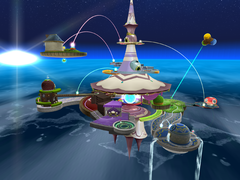
The Comet Observatory is the hub world in the game. It is a bridge between domes and serves as a place for the player to rest in between missions.[20] It is a sprawling structure similar to a palace, with a tall central spire and ornamental architecture. These attributes visually make it reminiscent of Princess Peach's Castle, the hub of Super Mario 64. The core of the observatory is a comet called the beacon that is fueled by Power Stars. The beacon is what allows the Comet Observatory to travel through space, but it remains in orbit around Mario's home planet throughout most of the game. The observatory has two extraplanetary satellites: the Planet of Trials and a grassy platform that holds the Gate. The platform is directly anchored to the observatory via Warp Pads and can be considered a direct extension of it, unlike the Planet of Trials.
Including Gateway Galaxy, there are nine galaxies directly accessed from the Comet Observatory. Six of these galaxies come from the Hungry Lumas affiliated with each dome. Unlike the hub worlds of Super Mario Galaxy's predecessors, there are no hidden Power Stars directly found on the observatory, though accessing the Planet of Trials, entering the Gate, and the arrival of Hungry Lumas are framed similarly. Five 1-Up Mushrooms are hidden in the observatory. Most of the observatory is obscured by darkness when Mario first arrives due to the abduction of its Power Stars and only the Terrace can be accessed. As Mario collects Power Stars, energy is restored to the observatory and new areas become lit to convey that they are now accessible. Warp Pads dot the Comet Observatory. They can be used to quickly reach adjacent locations on the hub. A Red Star appears above the Bedroom once Mario completes "Gateway's Purple Coins". Touching it transforms him into Flying Mario and allows him to soar through the skies of the observatory. There is nothing on the observatory that can harm Mario, and he will safely be transported back to solid ground if he falls off its edge.

The Comet Observatory is a nursery ground for Lumas. They are cared for by Rosalina, who treats them as if they were her children. As light is restored to the observatory, more and more Lumas appear. It was built by Rosalina when she was a child with an apricot-colored Luma. Over time, as more Lumas arrived and needed care, she expanded its size. The Comet Observatory visits Mario's home world once every hundred years, which is celebrated in the Mushroom Kingdom as the Star Festival. When the beacon is at its maximum size, Rosalina can make the observatory fold into the shape of a rocket ship and soar through the sky like a comet. The domes are framed as an extension of the observatory that provide a view of the cosmos. Each one is themed around rooms in a house, such as the bedroom, kitchen, and so on. There are two locations similar in concept that are not domes on the observatory: the garage and the library. The garage is framed as an intergalactic repair shop that starships can dock to. This is where the Toad Brigade and Luigi establish themselves once "Bee Mario Takes Flight" and "Luigi and the Haunted Mansion", respectively, are completed.
The library is a closed off space behind the beacon that becomes accessible once "The Fiery Stronghold" is completed. Though entered like a dome, there are no galaxies here. It contains no collectibles or anything related to the rescue of Princess Peach. The are no tangible incentives for coming to the library, and the player is never forced to enter it. This is where Rosalina reads a storybook to the Lumas. New chapters become available as Mario[note 1] accumulates Power Stars. The book details her personal backstory, the history of the Comet Observatory, Luma behavior, and provides insight into the past of the apricot-colored Luma that travels with Mario. This part of the game was created by Yoshiaki Koizumi and included at the discretion of Shigeru Miyamoto. Rosalina's Story is noted for its heartfelt and melancholy elements.[19][20] The illustrations on the pages have been likened to The Little Prince.[21]
Characters
Playable characters
| Name | Description |
|---|---|
 Mario |
The hero of the Mushroom Kingdom and the game's protagonist. After being invited to celebrate the Star Festival at Peach's Castle, an abduction cuts the party short and leaves Mario isolated on another planet far from home. It is here that he meets an apricot-colored Luma and his caretaker - the mysterious Rosalina. With the Luma bestowing him with the power to travel through space, Mario strives to collect Power Stars, rescue Princess Peach, and stop Bowser from creating his galaxy at the center of the universe. His movement options and overall feel are more directly comparable to Super Mario 64 than they are to the previous 3D Super Mario game. |
 Luigi |
Mario's younger brother. He can be used to replay the game after collecting 120 Power Stars and completing "The Fate of the Universe" as Mario. He can jump higher and run faster than Mario, but at the cost of reduced traction and increased startup. This causes Luigi to skid as he moves, and increases the risk of him falling off of a platform or colliding with an obstacle. In addition, the Spin Jump's height difference between shaking the Wii Remote and Nunchuk is switched. He otherwise appears as a supporting character who goes on quests to collect Power Stars for his brother. He still fulfills this supporting role during Luigi's playthrough, leading to a situation where there are two of them. Luigi can be quite cowardly and is deathly afraid of ghosts. |
Non-playable characters
With the exception of Princess Peach, Toads, and penguins, all of the characters encountered by the player are completely new to the Mario series. Most characters are met in various galaxies, though Rosalina, the Toad Brigade, and the Lumas are found on the Comet Observatory.
| Name | Description | Locations |
|---|---|---|
 Apricot Luma |
Mario's traveling companion - a young Luma who resides under his cap. He grants Mario[note 1] the ability to spin and travel through space. Before being kidnapped, Princess Peach was going to give this Luma to Mario as a gift during the Star Festival. It is implied that he is a reincarnation of the first Luma that Rosalina ever encountered. | All galaxies |
 Princess Peach |
The ruler of the Mushroom Kingdom. She is kidnapped by Bowser on the night of the Star Festival and taken to the center of the universe. The game follows Mario's quest to save her. She periodically sends letters of encouragement to Mario that contain 1-Up Mushrooms. She does so even during Luigi's playthrough. Rosalina refers to Peach as Mario's "special one". | Castle Gardens Bowser's Galaxy Reactor |
 Rosalina |
A mysterious woman who serves as the guardian of the cosmos. She travels through space via the Comet Observatory, a vessel she built for the Lumas. It is abruptly stopped and stripped of its power source, the Power Stars, by Bowser. Rosalina makes an arrangement with Mario where he collects Power Stars to restore power to the observatory. In return, she helps him stop Bowser and rescue Princess Peach. Her past is revealed to the player as they accumulate Power Stars via Rosalina's Story. The Lumas recognize Rosalina as their mother, who in return sees them as her family. | Comet Observatory Gateway Galaxy |
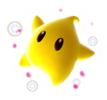 Lumas |
Star children that make their home in the Comet Observatory. Lumas appear in some galaxies to aid Mario, typically by transforming into Launch Stars. Lumas become celestial bodies when they grow up, and which ones they become is dependent on their color. Lumas eat Star Bits and squeal with delight when fed via the Star Cursor. | Comet Observatory Good Egg Galaxy Battlerock Galaxy Bowser's Star Reactor Bowser Jr.'s Airship Armada Bowser's Dark Matter Plant Gateway Galaxy Dreadnought Galaxy Bowser's Galaxy Reactor |
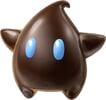 Polari |
An elderly Luma who serves as Rosalina's advisor. He appears within each dome of the observatory and grants access to the map when prompted. He teaches the player how to use the Star Cursor. | Comet Observatory |
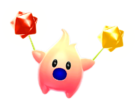 Hungry Lumas |
Big, voracious Lumas. The ones on the Comet Observatory transform into galaxies when fed a specified number of Star Bits. When encountered in dome galaxies, they transform into planets. Visiting them triggers a hidden mission. | Comet Observatory Good Egg Galaxy Space Junk Galaxy Battlerock Galaxy Dusty Dune Galaxy Sea Slide Galaxy Toy Time Galaxy Melty Molten Galaxy |
 Lumalee |
A big Luma that runs the Luma Shop. He typically proceeds a boss encounter and transforms into a Mushroom of choice in exchange for thirty Star Bits. | Battlerock Galaxy Ghostly Galaxy Bowser Jr.'s Airship Armada Melty Molten Galaxy Dreadnought Galaxy |
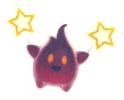 Comet Tico |
A big Luma that is knowledgeable about Prankster Comets. He provides details on these comets to the player when prompted. Alternatively, he can shift where a Prankster Comet appears in exchange for twenty Star Bits. | Comet Observatory |
 The Toad Brigade |
A five-member team of Toads on a quest to help find Princess Peach. They travel through space in search of Power Stars on a starship called a Starshroom. The Lumas built it for them. There are three Toads other than the red-capped leader and purple-capped postman that are part of the Brigade. There is a knowledgeable Blue Toad who typically provides information on an area of interest; a Green Toad who wields a pickaxe and constructs cannons for Mario; and a very sleepy Yellow Toad. | Comet Observatory Honeyhive Galaxy Sweet Sweet Galaxy Space Junk Galaxy Hurry-Scurry Galaxy Bubble Breeze Galaxy Ghostly Galaxy Bowser Jr.'s Airship Armada Freezeflame Galaxy Dusty Dune Galaxy Bigmouth Galaxy Sea Slide Galaxy Toy Time Galaxy Sand Spiral Galaxy Deep Dark Galaxy Grand Finale Galaxy |
 Toad Brigade Captain |
The captain of the Toad Brigade. This Red Toad self-designated himself as the brigade captain and typically sends his teammates into dangerous situations without his direct involvement. According to the Blue Toad, the captain is the most cowardly member of the team. | All galaxies that feature the Toad Brigade |
 Mailtoad |
A member of the Toad Brigade who runs a postal service for Mario on the Comet Observatory. He delivers mail from Princess Peach or Luigi. When out on missions with the brigade, he usually is equipped with a snorkel. | All galaxies that feature the Toad Brigade |
 Star Bunnies |
Spacefaring rabbits that like to play. They award Mario a Power Star for catching them. The Star Bunnies of Gusty Garden Galaxy have a penchant for gardening and are hunted by Undergrunts. Some Star Bunnies are Lumas in disguise. Unlike them, the real rabbits often end their sentences with "boiyoing" or sport Toad-like vests. | Gateway Galaxy Bowser Jr.'s Airship Armada Gusty Garden Galaxy Gold Leaf Galaxy Snow Cap Galaxy Grand Finale Galaxy |
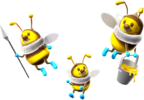 Honeybees |
Bee people that collect honey. They teach the player how to use their bee form. Most Honeybees are members of the Honeyhive Kingdom and are in the midst of a dispute with a society of stink bug-like Mandibugs. The bees of Gold Leaf Galaxy keep Cataquacks as pets. | Honeyhive Galaxy Sea Slide Galaxy Gold Leaf Galaxy Grand Finale Galaxy |
 Queen Bee |
The ruler of the Honeyhive Kingdom. Her body can be clung to by the player. Queen Bee's gentle and calm disposition contrasts with her large size. | Honeyhive Galaxy |
 Boards |
Talking boards that call out to Mario and teach him unique mechanics. Different individuals teach different things: Gil Board teaches Mario how to Wall Jump; Bill Board teaches him how to use the Rolling Ball; Phil Board teaches him how to use the Bubble; and Jill Board reminds him how to use his Boo form. | Honeyhive Galaxy Rolling Green Galaxy Bubble Breeze Galaxy Gusty Garden Galaxy Melty Molten Galaxy Boo's Boneyard Galaxy Rolling Gizmo Galaxy Bubble Blast Galaxy Grand Finale Galaxy |
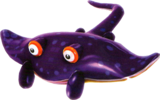 Ray |
The ray that Mario surfs on during the ray surfing minigame. Safely reaching the finish line within a specified time limit awards Mario with a Power Star. | Loopdeeloop Galaxy Loopdeeswoop Galaxy |
 Penguins |
Carefree, flightless birds who love swimming. Some individuals share swimming techniques with Mario when prompted, while others try to play with him. Most penguins are young birds that are a little shorter than Mario, but the two adults in the game – Coach and Penguru – tower over him. | Loopdeeloop Galaxy Beach Bowl Galaxy Buoy Base Galaxy Drip Drop Galaxy Freezeflame Galaxy Sea Slide Galaxy Loopdeeswoop Galaxy Grand Finale Galaxy |
 Coach |
A big penguin that teaches young birds how to swim. He has a kind and paternal disposition. Coach is the host of the ray surfing minigame and gives Mario a tutorial on how to move Ray. | Loopdeeloop Galaxy Beach Bowl Galaxy Loopdeeswoop Galaxy Grand Finale Galaxy |
 Penguru |
A knowledgeable, elderly penguin who likes to fish. While he oversees young penguins, he prefers spending time by himself. | Drip Drop Galaxy Bigmouth Galaxy Sea Slide Galaxy Grand Finale Galaxy |
 Penguin Racers |
A competitive, four-member swimming team of young penguins. While most penguins have blue plumage, each member of this team is a different color. They challenge Mario to a race when prompted. The team captain – a red penguin with yellow, brow-like feathers – awards Mario a Power Star for outswimming them. | Sea Slide Galaxy Grand Finale Galaxy |
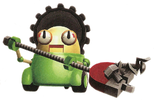 Gearmos |
Maintenance robots with an obsession for orderliness. Many Gearmos can be found upkeeping battle stations affiliated with the malicious Topman Tribe, but they themselves are benevolent robots. The Gearmos of Toy Time Galaxy teach the player how to make the most out of their spring form. An overworked individual hosts the Bob-omb Blasting minigame. Another helps maintain the Comet Observatory's Engine Room. | Comet Observatory Battlerock Galaxy Buoy Base Galaxy Toy Time Galaxy Dreadnought Galaxy Grand Finale Galaxy |
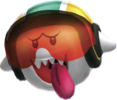 Spooky Speedster |
An Atomic Boo in a helmet. He challenges Mario to race through open space when prompted. He begrudgingly gives Mario a Power Star if he reaches the finish line before him. | Ghostly Galaxy Boo's Boneyard Galaxy |
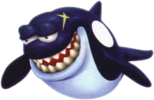 Guppy |
A fearsome orca whale who bullies the penguin racers. He only relents if Mario can pass through his eight-ring swim challenge, as well as award him a Power Star. Unlike most other characters, Guppy cannot be jumped on and – while not damaging – knockbacks Mario if approached. | Sea Slide Galaxy Deep Dark Galaxy |
 Cosmic Mario |
An entity that takes on the form of Mario and has all of the same abilities. He challenges him to a footrace to a Power Star. He only appears when a Cosmic Comet is in orbit during Mario's playthrough. Making contact with Cosmic Mario during the race makes him release Star Bits. | Honeyhive Galaxy Freezeflame Galaxy Gold Leaf Galaxy Sea Slide Galaxy |
 Cosmic Luigi |
An entity that takes on the form of Luigi and has all of the same abilities. Mirroring Cosmic Mario, he only appears when a Cosmic Comet is in orbit during Luigi's playthrough. He is a more challenging opponent than Cosmic Mario. | Honeyhive Galaxy Freezeflame Galaxy Gold Leaf Galaxy Sea Slide Galaxy |
Enemies and obstacles
Top row: Unagi, Moneybags, and Eyerok.
Bottom row: Gringill, Tracks, and Bouldergeist.
Roughly ninety enemies are in Super Mario Galaxy. Including bosses and obstacles, there are over one-hundred. Most enemies that can be defeated by Mario[note 1] drop different spoils depending on how they are attacked: enemies drop coins if stomped on and Star Bits if spun into. Most enemies that actively attack Mario briefly stop after successfully causing damage. This gives the player a chance to get their bearings before responding. Some enemies, such as Piranha Plants, laugh at Mario when they successfully land a hit.
Roughly fifty of the enemies and varieties in Super Mario Galaxy are wholly new to the series. Some of them are incorporated into subsequent Mario games or inspired staple elements. Notable groups include: octopus creatures called Electrogoombas, of which several varieties fire rocks; a faction of mechanical, spinning enemies called Topmen; and stationary robots that discharge circular electrical waves called Beamers. Though some enemies look like robots, there are no enemies visually comparable to the typical alien designs found in science fiction. Some of the new enemies are derivative of creatures that appeared in earlier Super Mario games in both design and behavior, with a particular focus on Super Mario 64 (see right). Some of them resemble recurring enemies in The Legend of Zelda series. Specifically, the bats resemble Keeses and the Electrogoombas resemble Octoroks. The Japanese name for an Electrogoomba relative even directly derives from the name "Octorok".
Super Mario Galaxy makes use of the Super Mario series' back catalog of enemies. This game represents the first instance that some of these enemies were ever integrated into a 3D platformer. There are enemies in Super Mario Galaxy that, with the exception of re-releases or remakes, never appeared outside of their debut titles. Many of these enemies debuted in Super Mario 64, such as Amps, Bomps, and Tox Boxes. The enemies that were incorporated contrast greatly with the ones in the previous 3D Super Mario game, a title that made a conservative use of the series' back catalog and introduced enemies that largely never appeared again.
Nearly all of the enemies and bosses in Super Mario Galaxy are incorporated into its sequel.
New enemies
| Name | Locations | Possible spoils | |
|---|---|---|---|
 Ball Beamer (bolt) |
A stationary enemy that discharges wide-ranging shockwaves on the surface of a spherical planet. The shockwaves damage Mario on contact. They are discharged in consistent three-part intervals that can be timed. The bolt can be unscrewed by spinning on top of it, which halts the discharge. This opens up the inside of the planet it sits on. | Buoy Base Galaxy | None |
 Ball Beamer (nut) |
Ball Beamers with nuts. One sits opposite of a bolted Ball Beamer on a spherical planet. These variants lack interactive components. | Buoy Base Galaxy Deep Dark Galaxy |
|
 Bat |
Winged creatures that roost in caves and swoop down to attack Mario. They fly in place and cackle when they make successful strikes. Bats can be defeated with a spin or stomp. | Beach Bowl Galaxy Ghostly Galaxy Toy Time Galaxy |
|
 Bomb Boo |
Explosive Boos. Unlike normal Boos, Bomb Boos do not cower when faced by Mario. They charge directly towards him on sight. Spinning near a Bomb Boo causes Mario to grab onto its tongue and swing it in circles, like a lasso. It detonates if it is swung into an object or wall. If Mario does not release the Bomb Boo, it is pulled in closer and explodes in his face. Bomb Boos are conjured by Bouldergeist and can be used to destroy the boss's stone armor. | Ghostly Galaxy | None |
 Bonefin |
Undead sharks. They appear during the boss fight with Kingfin, who summons them from a hydrothermal vent as he accumulates damage. They home in and charge at Mario when he comes in close proximity to them. They otherwise swim alongside Kingfin. They can be defeated by leading them to the water's surface or by striking them with a shell. The entire guard disappears once Kingfin is defeated. | Bonefin Galaxy | |
Clampy |
A giant clam that periodically opens and shuts its valves. Either Star Chips or coins can be found within them. Snapping shut with Mario inside damages him. | Beach Bowl Galaxy | |
 Cluckboom |
Red Plurps that lay explosive eggs. They fly in a continuous set path, fluttering back and forth. They fall to the ground if shot at with Star Bits, which leaves them dazed and open to attack. | Dusty Dune Galaxy | |
Crabber (Blue) |
Evasive, sidestepping crabs that frantically scuttle away from Mario. Crabbers have hard shells that protect them from jumps and spins head-on, but their fleshy rears are exposed and can be struck. Blue Crabbers bury themselves underground in an attempt to escape and resurface shortly after. | Dusty Dune Galaxy Sea Slide Galaxy Deep Dark Galaxy Bigmouth Galaxy |
|
Crabber (Red) |
Offensive Crabbers. Red Crabbers actively pursue Mario, but move slowly. | Dusty Dune Galaxy Sea Slide Galaxy Deep Dark Galaxy Bigmouth Galaxy |
|
Electrogoomba |
Goomba-like octopus creatures. They sidestep back-and-forth along a set back and keep their eyes locked onto Mario when he is nearby. If in close proximity, they attempt to strike him with the hair-like protrusion on their heads. Electrogoombas can be defeated by spinning them once or jumping on their heads. | Good Egg Galaxy Battlerock Galaxy Bowser Jr.'s Airship Armada Toy Time Galaxy |
|
 Eye Beamer |
Mechanical eyes that are suspended in the air. They emit electrical beams from their pupils that damage Mario on impact. Some Eye Beamers move while others are stationary. The back of the Eye Beamer is undamaging and flat: they can be used as platforms to traverse obstacles. | Dusty Dune Galaxy Dreadnought Galaxy |
|
 Fire Shooter |
Mounted flamethrowers that periodically shoot streams of fire. The flames recede in set intervals that can be timed. | Bowser's Star Reactor Toy Time Galaxy Deep Dark Galaxy Bubble Blast Galaxy |
|
 Flipbug |
Skittish beetles. When Mario is in close proximity, they cowardly try to fly away before tiring out and falling to the ground, flailing helplessly. If spotted in his bee form, they aggressively pursue him. | Honeyhive Galaxy Gusty Garden Galaxy Gold Leaf Galaxy |
|
 Giant Gringill |
Large Gringills found in underwater caves. They bite Mario if he approaches the mouth of their caves. | Beach Bowl Galaxy Sea Slide Galaxy Deep Dark Galaxy |
|
 Golden Chomp |
A rolling Chomp made of gold. It can only be destroyed by Mario if he collides with it while in his rainbow form. | Gusty Garden Galaxy | |
 Goombeetle |
Robotic-looking Goombas that wear metallic helmets. The helmets protect them from being stomped. Spinning them makes them fall upside down. They can be defeated in this state. | Bowser Jr.'s Robot Reactor Battlerock Galaxy Buoy Base Galaxy Bowser's Dark Matter Plant Dreadnought Galaxy |
|
 Gringill |
Giant eels that prey on penguins. They are found nestled in caves and swimming in open waters with snapping jaws. The nesting individuals snap at Mario if he approaches the mouth of their caves. They can only be defeated by projectile shells. | Beach Bowl Galaxy Sea Slide Galaxy Drip Drop Galaxy Deep Dark Galaxy Bigmouth Galaxy |
|
 Ground Urchin |
Red Urchins only found on land. One protracts its spines and rolls towards Mario if he approaches it. They are immune to spinning or being stomped. They can only be damaged by fire and lava. There is a box-like stone sculpture in Freezeflame Galaxy that continuously expels these Urchins. | Freezeflame Galaxy Deep Dark Galaxy |
|
 Ice bat |
White bats shrouded in an icy vapor. Making direct contact encases Mario in ice. They can only be damaged by fire. | Freezeflame Galaxy | |
 Ice Bubble |
Floating ice enemies that freeze Mario on contact. Spinning near them neutralizes their icy cloud and forces them to the ground. This leaves them vulnerable to being kicked. Neutralized Ice Bubbles propel themselves towards the nearest pool of freezing water to regenerate their cold aura. | Freezeflame Galaxy Toy Time Galaxy |
|
 Jam-o'-War |
Large Jammyfish that electrocute Mario on contact. They idly pulsate in place and emit a low, otherworldly sound. Jellyfish can be defeated by throwing two shells at them. The first strike turns them green, but their behavior is unchanged. | Deep Dark Galaxy Bigmouth Galaxy |
|
 Jammyfish |
Jellyfish that idly swim in schools along a set path. They damage Mario on contact, but do not actively pursue him. | Deep Dark Galaxy Bigmouth Galaxy |
|
 Li'l Cinder |
Floating fire enemies that burn Mario on contact. Spinning near them extinguishes their flame and leave them vulnerable to being kicked. Extinguished Li'l Cinders hop towards the nearest pool of lava to reignite. | Freezeflame Galaxy Melty Molten Galaxy |
|
 Mandibug |
Large stink bug-like enemies that prey on Honeybees. They quickly charge towards Mario in a straight line after making visual contact, snapping at him with their mandibles. They can be defeated by Ground Pounding them on their backs, as indicated by the symbol on their abdomen. Mandibugs cower in fear if Mario stands on their back but eventually shake him off. | Honeyhive Galaxy Bowser Jr.'s Airship Armada Honeyclimb Galaxy Gold Leaf Galaxy |
|
 Meteor |
Fiery space rocks. Bowser shoots them out of his mouth to destroy the big staircase in Bowser's Star Reactor, and Bowser Jr. fires them from the cannons in his airship in Bowser's Galaxy Reactor. They otherwise typically appear raining from the sky in volcanic galaxies. | Bowser's Star Reactor Honeyclimb Galaxy Bowser Jr.'s Lava Reactor Melty Molten Galaxy Gateway Galaxy Bowser's Galaxy Reactor |
None |
Mikey Mine |
Naval mines that have eyes and bob up and down on chains. They keep their eyes shut unless Mario is in close proximity. They regenerate after detonating. | Deep Dark Galaxy | None |
 Mini Chomp |
Small Chomps that roll out of doghouses. Mini Chomps cannot be damaged directly: they are only destroyed once all nearby Flipswitch Panels are activated. | Dreadnought Galaxy | |
 Monty |
Bandana-wearing moles that reside in hatches and throw wrenches at Mario. They close and hide in the hatch if he approaches them. Montys can be stunned by Ground Pounding the earth near them or shooting them with a Star Bit. This leaves them vulnerable to attack. | Battlerock Galaxy Gusty Garden Galaxy Dreadnought Galaxy |
|
Octoguy |
Small Electrogoombas that shuffle backwards from Mario when approached. They periodically stop to shoot a rock at him. Octoguys are defeated with a spin or jump. They often appear in large groups. | Honeyhive Galaxy Buoy Base Galaxy Bowser Jr.'s Airship Armada Gold Leaf Galaxy Deep Dark Galaxy |
|
Pokeyplant |
A red Pokey that can move. It shimmies back from Mario while attempting to slam its head into him. The Pokeyplant can be defeated by destroying its body segments and then its head, or by stomping on its head from above. If reduced to just a head, it attempts to flee. | Dusty Dune Galaxy | |
 Prickly plant |
Idle plants with sharp, needle-like flowers. They damage Mario on contact. Destroying them without a power-up usually requires striking them with another object, such as a coconut or rubbery bulb. | Good Egg Galaxy Gusty Garden Galaxy Dusty Dune Galaxy Toy Time Galaxy Gateway Galaxy Bowser's Galaxy Reactor |
|
 Prickly plant (giant) |
Large prickly plants. Their behavior is shared with the normal-sized prickly plants. | Good Egg Galaxy Dusty Dune Galaxy |
|
 Prickly plant (sky) |
Giant prickly plants suspended in space. They have rotating, propeller-like leaves underneath their flowers. | Gusty Garden Galaxy | |
 Pumpkinhead Goomba |
Slow-moving Goombas with jack o'lanterns covering their heads. They periodically leave blue flames that damage Mario on contact. Pumpkinhead Goombas can be defeated in one hit with a Ground Pound, or spinning them to destroy their pumpkin, turning them into a regular Goomba. | Ghostly Galaxy | |
 Ring Beamer |
Domed machines covered in spikes that emit circular shockwaves. The shockwaves cause electrical damage. They cannot be damaged or halted by any means. Unlike Ball Beamers, attempting to jump on Ring Beamers damages him. | Toy Time Galaxy Dreadnought Galaxy |
|
Rocto |
Large and stationary alien Octoroks that hide in barrels. They shoot coconuts[note 2] and flaming rocks at Mario. The coconuts can be deflected back at them if spun against. Roctos are always found in pairs. | Good Egg Galaxy Space Junk Galaxy Bowser Jr.'s Lava Reactor Dreadnought Galaxy |
None |
 Sentry Beam |
Stationary robots suspended above ground via a propeller. They shoot electric lasers from their maw. Sentry Beams are completely invincible, although standing on top of them temporarily prevent it from firing. They follow Mario's position when he is close. | Battlerock Galaxy Bowser Jr.'s Airship Armada Toy Time Galaxy |
|
 Sentry Garage |
A large Topman that releases four Topminis out of its sides. After jumping on its head, it can be used as a spring to reach higher areas. | Buoy Base Galaxy | None |
 Slurple |
Leech-like parasites related to Electrogoombas. They latch onto Mario and gradually deplete life meter. Slurples are easily disposed of with a spin. | Good Egg Galaxy Honeyhive Galaxy Gusty Garden Galaxy Gold Leaf Galaxy Sea Slide Galaxy |
|
 Spiky Topman |
Top enemies that spin into Mario. Spiky Topmen do not directly harm him, but they can push him into hazards or off of a platform. The spike on their heads protects them from being stomped on and damage him on contact. Spiky Topmen can only be defeated if into an electric rail or off the side of a platform. | Battlerock Galaxy Dreadnought Galaxy |
|
 Spiny Piranha Plant |
Giant Piranha Plants that forcefully slam their heads into the ground. They can be defeated by jumping on their heads, or stunned by spinning into them. | Good Egg Galaxy Beach Bowl Galaxy Gusty Garden Galaxy |
|
 Spoing |
Spiders that hop up and down in place. To defeat Spoings, they can be stunned with a Star Bit and kicked, or simply jumped on. They gleefully laugh if they successfully strike Mario. | Space Junk Galaxy Ghostly Galaxy |
|
 Sprangler |
Spoings that hang from silk. They sway back and forth in an attempt to strike Mario. Spranglers become briefly incapacitated if spun into and can be kicked to defeat them. They otherwise can be jumped on. | Ghostly Galaxy Bowser Jr.'s Airship Armada Sea Slide Galaxy |
|
Spring |
Mechanical spring enemies. They knockback Boo Mario on contact but do not cause damage. | Boo's Boneyard Galaxy | |
 Spring Topman |
Green Topmen. Colliding with Mario causes him to spin out of control. Jumping on one's head leaves it stunned and exposes the spring underneath its head. It can be jumped on while in this state to reach great heights. Some Spring Topmen can produce single Topminis. | Buoy Base Galaxy Dreadnought Galaxy |
None |
Spring Vault |
Spring-like Ring Beamers. They can be used as springs after jumping on their head, allowing Mario to reach great heights. | Flipswitch Galaxy Battlerock Galaxy Dreadnought Galaxy |
None |
 Topmini |
Tiny Topmen that can be defeated by spinning into them. Topminis are incapable of damaging Mario and can only push them around. There are dark voids continuously produce Topminis. They otherwise are produced by Spring Topmen and Sentry Garages. | Buoy Base Galaxy Dreadnought Galaxy |
|
Tracks |
Sandal-wearing sack creatures that turn invisible when moving. Tracks are harmless, but can be defeated to recover a large number of Star Bits. Their movement can be tracked by following their footsteps. | Good Egg Galaxy Gusty Garden Galaxy Sea Slide Galaxy Deep Dark Galaxy Gateway Galaxy |
|
 Tweester |
Miniature dust tornadoes that travel along a set path. They catch Mario in their gusts when they make contact, but this does not harm him. Mario is propelled high into the air like a bamboo-copter if he tries to spin. Some Tweesters carry jagged, rocky debris that harms Mario if he makes contact. | Dusty Dune Galaxy | |
Undergrunt |
Burrowing moles that prey on Star Bunnies. They leave trails of disturbed dirt as they burrow through the ground. They can be defeated by ground-pounding approximal earth. This forces them to the surface and dazed, leaving them vulnerable to being spun. Their spiked helmets damage Mario if he tries to jump on them. The helmets protrude from the ground as the Undergrunts burrow, enabling the player to track their movements. | Gusty Garden Galaxy Gold Leaf Galaxy |
|
 Water Shooter |
Mounted nozzles that shoot large drops of water over great distances. A drop traps Mario if he is within its trajectory and carries him with it. He is freed if he spins. | Honeyhive Galaxy Buoy Base Galaxy Deep Dark Galaxy Sand Spiral Galaxy |
Returning enemies
| Name | Locations | Possible spoils | |
|---|---|---|---|
 Amp |
Suspended, magnetic orbs with smiling faces. They discharge electricity and shock Mario on contact. They move in a fixed direction, typically in a circular pattern. | Buoy Base Galaxy Dreadnought Galaxy Bubble Blast Galaxy |
|
 Atomic Boo |
A gigantic Boo. It can only be defeated with a light source. A rival character called the Spooky Speedster is of this species. | Deep Dark Galaxy | |
 Banzai Bill |
Giant, slow-moving missiles with sharkmouths. Their line of trajectory is fixed in one direction, and they slowly rotate as they move. | Bowser's Galaxy Reactor | None |
 Blooper |
White squids. They swim erratically when approached by Mario in an attempt to strike him. They can be defeated with a spin or a shell. Bloopers release a cloud of ink when defeated by the player. | Buoy Base Galaxy Deep Dark Galaxy |
|
 Bob-omb |
Walking bombs that look like wind-up toys. There are two varieties: Bob-ombs that actively pursue Mario until they explode and legless bombs than can be picked up and thrown. The legless variety can be used to destroy cages, enemies, and trash in the Bob-omb Blasting minigame. Jumping on a walking Bob-omb causes its legs to recede into its body and become this second variant. | Battlerock Galaxy Dreadnought Galaxy Rolling Gizmo Galaxy |
None |
 Bomp |
Large, moving stones that shift in and out of crevices found on walls. They do not damage Mario directly, but they are positioned to push him off of platforms and solid ground. The tops of their bodies can be walked on. | Buoy Base Galaxy Freezeflame Galaxy |
|
 Boo |
Round ghosts with long tongues. They pursue Mario when his back is turned towards them. If Mario looks directly at Boos, they sheepishly shield their eyes and stop moving. Spinning them causes them to shift their position and forces them to phase through nearby walls, but they cannot be damaged this way. Boos are only weak to beacons of light – including the headlamp of the Toad Brigade Captain. Some can be found underwater. Mario can transform into one via the Boo Mushroom. Normal Boos become infatuated with Mario if encountered in his Boo form. | Ghostly Galaxy Deep Dark Galaxy Bigmouth Galaxy Sand Spiral Galaxy |
|
 Bullet Bill |
Angry-looking missiles that are fired from Bill Blasters. They normally fly in a straight line, but they change course and directly target Mario if he is within their proximity. Mario can lure Bullet Bills towards cages and fences in order to destroy them. Their eyes flash with red light and their bodies twirl when they lock onto Mario. | Good Egg Galaxy Bowser Jr.'s Robot Reactor Battlerock Galaxy Buoy Base Galaxy Bowser Jr.'s Airship Armada Bowser Jr.'s Lava Reactor Dreadnought Galaxy Melty Molten Galaxy Bowser's Galaxy Reactor Bubble Blast Galaxy |
None |
 Cannonball |
Round ammunition shot from enemy cannons. They maintain a straight, horizontal trajectory and move relatively slowly. They burst when they make contact with Mario. A cannonball can be taken out by shooting it with a Star Bit. | Battlerock Galaxy Bowser Jr.'s Airship Armada Gusty Garden Galaxy Sling Pod Galaxy Dreadnought Galaxy |
|
 Cataquack |
Vaguely duck-like creatures that toss Mario high into the air. This does not harm him. They immediately charge towards Mario after making visual contact. They otherwise idly pace in circles or sleep on the ground. Spinning them or performing a Ground Pound temporarily dazes them. They cannot swim and drown if led into water. | Beach Bowl Galaxy Gold Leaf Galaxy |
None |
 Cheep Cheep |
Pudgy red fish. Underwater, they passively swim in circles. On land or shallow water, they hopelessly bounce around in a set trajectory. They can be defeated with a spin or a jump. | Deep Dark Galaxy | |
 Chomp |
Toothy, metal monsters that roll in a set trajectory. The only way to defeat them is by running into them with a Rainbow Star. They bark like a dog when in close proximity. A cannon in Good Egg Galaxy expels smaller variants of Chomps. | Good Egg Galaxy Battlerock Galaxy Ghostly Galaxy |
|
 Dry Bones |
Undead Koopa Troopas. They chase down and tackle Mario on sight. If stomped on, spun, or hit with a shell, Dry Bones crumble into a pile of bones, but regenerate after a few seconds. There are three ways to truly defeat Dry Bones: by luring a Bullet Bill into them; by running into them as Rainbow Mario; or by luring them into quicksand. | Dusty Dune Galaxy Bowser's Dark Matter Plant Bowser's Galaxy Reactor |
|
 Goomba |
Squat mushroom beings that rush down Mario when he is in their line of sight. Goombas can be defeated with a single jump. Spinning or shooting them with Star Bits causes them to flip over and spin like a top. They can be kicked or stomped on in this state. Pumpkinhead Goombas become these if not fully defeated. | Good Egg Galaxy Space Junk Galaxy Rolling Green Galaxy Battlerock Galaxy Hurry-Scurry Galaxy Beach Bowl Galaxy Buoy Base Galaxy Bowser Jr.'s Airship Armada Gusty Garden Galaxy Freezeflame Galaxy Dusty Dune Galaxy Bowser's Dark Matter Plant Gold Leaf Galaxy Bowser Jr.'s Lava Reactor Gateway Galaxy Deep Dark Galaxy Dreadnought Galaxy Rolling Gizmo Galaxy |
|
 Grand Goomba |
A gigantic Goomba. It can only be defeated with a spin and a kick. | Gateway Galaxy | |
 Koopa Troopa (Green) |
Green-shelled turtles. They walk back and forth in a straight line. When jumped on, they retreat into their shells, allowing Mario to pick it up and use it as a Green Shell. | Space Junk Galaxy Bowser Jr.'s Airship Armada Dusty Dune Galaxy Sea Slide Galaxy Dreadnought Galaxy Bigmouth Galaxy |
|
 Koopa Troopa (Red) |
A red-shelled Koopa Troopa that walks around in a circle. Jumping on it causes it to retract and gives Mario access to a Red Shell. | Sea Slide Galaxy | |
 Lava Bubble |
Floating drops of lava that propel themselves towards Mario. Lava Bubbles appear during the boss battle with King Kaliente. They can only be defeated by shooting them with a Star Bit and otherwise burnout on their own. | Good Egg Galaxy Bowser Jr.'s Lava Reactor Melty Molten Galaxy |
|
 Magikoopa |
Robed Koopas that can teleport. They conjure fireballs and toss them at Mario with their wand. Shooting one with a Star Bit does not leave it dazed, but it does stall to block the bit. A Magikoopa featured in one of the opening cutscenes is localized in English as "Kamek". | Space Junk Galaxy Bowser Jr.'s Airship Armada Toy Time Galaxy Deep Dark Galaxy Matter Splatter Galaxy Sand Spiral Galaxy |
|
 Mecha-Bowser |
Mechanical Koopas that breathe fire. They can only be defeated with a Ground Pound. Spinning them causes their heads to swing back and briefly delays their fire breath attack. | Toy Time Galaxy Dreadnought Galaxy |
|
 Micro Goomba |
Diminutive and weak Goombas. Like normal-sized Goombas, they charge towards Mario if he is near. They can be defeated with a single spin. | Rolling Green Galaxy Battlerock Galaxy Freezeflame Galaxy Dusty Dune Galaxy Bowser Jr.'s Lava Reactor Gateway Galaxy Dreadnought Galaxy Rolling Gizmo Galaxy |
|
 Piranha Plant |
Carnivorous plants that lunge out at Mario with snapping jaws if approached. They scoffingly laugh if they make a successful bite. Piranha Plants can be defeated with a spin or a stomp, and can be stunned by shooting a Star Bit at one. Sproutle Vines sometimes grow from where a Piranha Plant is defeated. They idly keep their heads raised skyward when unapproached. | Good Egg Galaxy Honeyhive Galaxy Beach Bowl Galaxy Gusty Garden Galaxy Dusty Dune Galaxy Gold Leaf Galaxy |
|
 Pokey Head |
Disembodied Pokeys. They are buried with only their flowers visible. When approached by Mario, they burst out of the ground and start hopping after them. A Pokey Head gleefully bounces in place if it successfully strikes Mario. They can be defeated in a single hit with a spin or stomp. | Gusty Garden Galaxy Dusty Dune Galaxy |
|
Pokeynut |
Segmented cactus enemies. They slam their heads downward to strike Mario. Their bodies fall apart when struck by coconuts, causing their head to fall and be partially submerged in the surrounding sand. Stomping on their overturned heads defeats them. | Good Egg Galaxy Dusty Dune Galaxy |
|
 Ruby Rock |
Giant, rolling rocks. They are composed of cragged stones with a red gem in their center. Boulders roll around in circles or off the sides of platforms, damaging Mario on contact. Striking them in their red gem with a spin destroys them. There are cliffside caves that continuously release Boulders indefinitely in several galaxies. | Good Egg Galaxy Honeyhive Galaxy Gusty Garden Galaxy Freezeflame Galaxy Dusty Dune Galaxy Gold Leaf Galaxy Melty Molten Galaxy |
|
 Space Mine |
Spiked bombs that are suspended in mid-air. They are usually fixed in one spot, but some move in vertical and horizontal trajectories in a few galaxies. Making contact with a mine causes it to explode in Mario's face, causing damage. They can be destroyed by shooting them with a Star Bit. | Battlerock Galaxy Bubble Breeze Galaxy Ghostly Galaxy Bowser Jr.'s Airship Armada Sling Pod Galaxy Dreadnought Galaxy Sand Spiral Galaxy Bubble Blast Galaxy |
None |
 Spike Trap |
Spiked platforms that slide along a set path, damaging Mario if they touch its sharp edges. | Good Egg Galaxy Flipswitch Galaxy Toy Time Galaxy |
|
 Spiny Cheep-Cheep |
Rare pufferfish enemies. They protract their spines and charge towards Mario on sight. They can only be found hidden within sunken Treasure chests. | Drip Drop Galaxy | |
 Thwomp |
Giant, grimacing stones. They hang suspended in mid-air but periodically slam down towards the ground with violent force. Crushing Mario completely depletes his life meter. The tops and sides of their bodies can be used as platforms and walls, respectively. A slightly smaller variant appears in Dreadnought Galaxy. | Bowser's Star Reactor Beach Bowl Galaxy Buoy Base Galaxy Dusty Dune Galaxy Dreadnought Galaxy Melty Molten Galaxy Bowser's Galaxy Reactor |
|
 Tox Box |
Giant, solemn-looking boxes made out of stone. They roll around in set trajectories. One of their sides is open and can be safely stood under. All other sides crush Mario. Tox Boxes are the same width of the paths they travel, making them difficult to avoid. | Beach Bowl Galaxy Toy Time Galaxy |
|
Torpedo Ted |
Underwater missiles with smiley sharkmouths. Their eyes flash red and they home in on Mario when he is in close proximity. They can be lured towards glass cages to break them. | Buoy Base Galaxy Drip Drop Galaxy |
None |
 Urchin |
Benthic creatures with protractible spines. They aggressively roll towards Mario when he is in close proximity. They can only be damaged by shells and fireballs. | Beach Bowl Galaxy Buoy Base Galaxy Freezeflame Galaxy Sea Slide Galaxy Drip Drop Galaxy Deep Dark Galaxy |
|
 Wiggler |
Caterpillars that amble around in circles. Performing a ground-pound on nearby earth or directly spinning one flips a Wiggler on its back. If the incapacitated Wiggler is not defeated within five seconds, it becomes angry and uprights itself. An enraged Wiggler is much faster and cannot be harmed. It returns to its original disposition after a few seconds. Wigglers can be defeated in a single hit by ground-pounding them. | Honeyhive Galaxy Beach Bowl Galaxy Bowser Jr.'s Airship Armada Gusty Garden Galaxy Gold Leaf Galaxy |
|
 Zap Ball |
Large Amps. They are typically in pairs. Unlike normal-sized Amps, the big ones lack faces. | Space Junk Galaxy Battlerock Galaxy Buoy Base Galaxy Gusty Garden Galaxy Toy Time Galaxy |
Obstacles
| Name | Locations | |
|---|---|---|
 Banzai Bill Cannon |
Giant cannons that shoot Banzai Bills. There are also identical-looking cannons in Good Egg Galaxy that release Chomps. | Bowser's Galaxy Reactor |
 Bill Blaster |
The cannons that shoot Bullet Bills. Stand-alone blasters are covered in military camouflage. A blaster will not shoot more than one Bill at a time. Bill Blasters are mounted onto the surface of planets, integrated into the walls of terrain, and attached to the sides of Bowser's airships. Many Bill Blasters are built into the body of Megaleg. There are identical-looking blasters found underwater that shoot Torpedo Teds. | Good Egg Galaxy Bowser Jr.'s Robot Reactor Battlerock Galaxy Buoy Base Galaxy Bowser Jr.'s Airship Armada Bowser Jr.'s Lava Reactor Dreadnought Galaxy Melty Molten Galaxy Bowser's Galaxy Reactor Bubble Blast Galaxy |
Black hole |
Extremely dense voids with their own gravity. Mario will be pulled into black holes if he gets too close and will lose a life. They exist in the center of several planets and function similarly to bottomless pits. | All galaxies except: Loopdeeloop Galaxy Rolling Green Galaxy Bubble Breeze Galaxy Buoy Base Galaxy Dusty Dune Galaxy Bonefin Galaxy Matter Splatter Galaxy Rolling Gizmo Galaxy Loopdeeswoop Galaxy Grand Finale Galaxy Drip Drop Galaxy Bigmouth Galaxy Snow Cap Galaxy |
 Bramble |
Thick vines covered in thorns. Making contact damages Mario. | Gusty Garden Galaxy |
 Burner |
Rare Bill Blaster-like cannons. They charge up for a few seconds before creating a small explosion. | Good Egg Galaxy |
 Cannon |
Mounted enemy artillery that shoots cannonballs. They are built into the sides of terrain. They fire continuously in set intervals that can be timed. | Battlerock Galaxy Bowser Jr.'s Airship Armada Gusty Garden Galaxy Sling Pod Galaxy Dreadnought Galaxy |
 Crystal wall |
Obstacles that obstruct Boo Mario's path. He can phase through them by shaking |
Boo's Boneyard Galaxy |
 Dark matter |
A dangerous substance with a swirling pattern on it. Mario's body visually disintegrates when he makes contact with dark matter and he loses a life. | Bowser's Dark Matter Plant |
 Dry Ice Planet[23] |
An ice planet. The surface is so cold that direct contact causes Mario to leap as if he was burned and reduces his life meter. | Bowser's Galaxy Reactor |
 Electric Ball[24] |
Metal orbs that move in a circle, causing Mario electrical damage if touched. | Battlerock Galaxy Dreadnought Galaxy |
 Electric beam |
A laser beam that moves in a circle, inflicting electrical damage on Mario if touched. It only appears on the beam planet of Dreadnought Galaxy. | Dreadnought Galaxy |
 Electric rail |
Electrical barriers which shock Mario on contact. They emit either green or red electricity and move horizontally in some galaxies. Spiky Topmen can be damaged by spinning them into an electric rail. | Good Egg Galaxy Flipswitch Galaxy Battlerock Galaxy Toy Time Galaxy Dreadnought Galaxy Sweet Sweet Galaxy Bubble Blast Galaxy |
 Fire Bar |
Rotating bars of fireballs that burn Mario on contact. | Battlerock Galaxy Bowser's Star Reactor Toy Time Galaxy Deep Dark Galaxy Melty Molten Galaxy Bowser's Galaxy Reactor Sling Pod Galaxy |
 Fireball |
Trailing clumps of molten rock that are shot out of lava. They move very slowly and burn Mario on contact. | Freezeflame Galaxy Melty Molten Galaxy Bowser's Galaxy Reactor |
 Freezing water |
Ice water. It is too frigid to swim in: staying in the water for too long depletes Mario's life meter. Freezing water is readily differentiated from normal bodies of water because the screen is briefly disrupted by a static-like visual effect when Mario enters it. | Freezeflame Galaxy |
 Gravity field |
A type of wall that controls the direction of gravity which pulls Mario or Luigi within its expanse. There are four different directions, each signified by a color: down (blue), up (red; occasionally pink), right (green), and left (gray). | Good Egg Galaxy Battlerock Galaxy Bowser's Star Reactor Bowser's Dark Matter Plant Bowser's Galaxy Reactor |
 Gravity spotlight |
Blue beams of light that have their own gravity. When Mario walks into one, he is pushed towards the direction of the light is being beamed. It enables him to walk on walls and ceilings, but only where the light is being directly struck. | Bowser's Galaxy Reactor |
 Honey |
A sweet substance collected by Honeybees. Honey reduces Mario's movement the same way mud does. | Honeyhive Galaxy |
| File:Nocoverart.png Industrial wall |
Moving walls that can move up and down and potentially crush Mario or Luigi. | Battlerock Galaxy Dreadnought Galaxy |
 Lava |
Molten rock. Direct contact burns Mario and makes him bounce into the air with his hands on his rear. It is emitted by volcanos and makes up the surface of some celestial bodies, such as suns. | Bowser's Star Reactor Freezeflame Galaxy Bowser's Dark Matter Plant Bowser Jr.'s Lava Reactor Melty Molten Galaxy Bowser's Galaxy Reactor |
Lava Geyser |
Columns of molten rock that rise from pools of lava. Direct contact burns Mario. Lava Geysers rise and fall in set intervals that can be timed. A rise is always proceeded by rapid bubbling on the lava's surface. | Freezeflame Galaxy Melty Molten Galaxy Bowser's Galaxy Reactor |
 Lava Mini Sun Planet[25] |
Small red dwarves. Some suns can be found suspended in space, while others can be found on the surface of planetoids. Making direct contact burns Mario. | Bowser's Star Reactor Freezeflame Galaxy Melty Molten Galaxy Bowser's Galaxy Reactor |
 Lava Steam |
Heated water vapor forced out of the ground. Making contact burns Mario. | Space Junk Galaxy Freezeflame Galaxy Melty Molten Galaxy Bowser's Galaxy Reactor |
 Mini doghouses |
Doghouses that spawn an endless amount of Mini Chomps. | Dreadnought Galaxy |
 Mud |
Dirt mixed with water. Mario's movement speed and jump height is greatly reduced when he is in mud. This puts him at potential risk if dangerous enemies are nearby. | Good Egg Galaxy |
 Poison swamp |
Bubbly, sludge-like poison mixed with water. Mario becomes trapped in the poison when he makes contact and will rapidly start to sink and lose a life. There is no way for the player to escape. | Bubble Breeze Galaxy Toy Time Galaxy |
 Quicksand |
Shifting sands. It functions identically to poison in that it will rapidly cause Mario to sink and he cannot escape its pull. Quicksand is usually denoted by signage that have skull-and-crossbones on them. | Dusty Dune Galaxy Sand Spiral Galaxy Bowser's Galaxy Reactor |
 Speedy sand |
Rapidly flowing sand. Mario can stand on it, but it will push him in the direction of its trajectory and potentially into hazards. | Dusty Dune Galaxy |
 Spotlight |
Beams of light. They can be used to defeat enemy Boos, but they will also force Boo Mario back into his normal form. | Ghostly Galaxy Deep Dark Galaxy |
 Whirlpool |
A swirling vortex of water. Contact pushes Mario and temporarily stuns him, but it does not cause damage. | Sea Slide Galaxy Deep Dark Galaxy Bigmouth Galaxy |
 Wind |
Gusts that are often generated by fans. It can either help or hinder Mario. | Bubble Breeze Galaxy Gusty Garden Galaxy Boo's Boneyard Galaxy |
Bosses
| white | white | white | white | white | |||||||||||||||
|---|---|---|---|---|---|---|---|---|---|---|---|---|---|---|---|---|---|---|---|
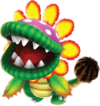
|
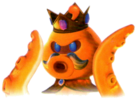
|

|

|
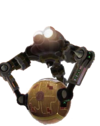
| |||||||||||||||
| A Piranha Plant monster with a clubbed tail. It charges down Mario when he is in its line of sight. Spinning into its club slingshots it towards its head, damaging it. Its charges more quickly after the first strike. | A giant Rocto that dwells in lava. He shoots coconuts and flaming rocks at Mario. Spinning into a coconut smacks it back towards him and damages him. He starts to parry these attacks as the fight progresses. | A Mandibug that carries its child on its back. Both can be defeated by performing a Ground Pound. Defeating the child enrages the parent and makes it harder to strike. | An enormous, winged Mandibug. It tries to bite Mario with its mandibles. Ground pounding its abdomen damages it. Bugaboom takes flight after being struck once and starts releasing explosive droppings as it flies. | A giant robot. Its legs are covered with gravitational panels that enable Mario to walk on its body, but it fires Bullet Bills at him as he ascends. A Grand Star is caged on its head that can be freed with a lured Bill. | |||||||||||||||
| Missions | Missions | Missions | Missions | Missions | |||||||||||||||
| Dino Piranha Dino Piranha Speed Run |
King Kaliente's Battle Fleet | Trouble on the Tower | Big Bad Bugaboom | Megaleg's Moon | |||||||||||||||
| white | white | white | white | white | |||||||||||||||

|

|

|
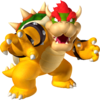
|

| |||||||||||||||
| A Magikoopa boss. She conjures fireballs, Green Shells, and other Magikoopas. Striking her with shells is the only way to damage her. She starts to teleport erratically as the fight progresses. | A giant spidery boss that cocoons itself in silk. The green orbs covering its body are its weak points: Mario can use Sling Pods to launch himself at them to damage it. It spews acid after being hit once. | A large Topman with serrated edges. Jumping on his head makes the blades retract, enabling Mario to safely spin him into an electric rail. | Mario's arch-nemesis: the fire-breathing king of Koopas. He launches himself skyward and back to produce seismic shockwaves and strike Mario. Luring him above a glass panel causes him to crash through and burn his tail on lava. This leaves him vulnerable to a spin attack. He can conjure stone armor and roll like a boulder. He otherwise uses attacks that mirror Mario's abilities, including the spin and Side Somersault. | A large ghost covered in rocks. It launches rocks and erects stone spikes to damage Mario. Attacking it with Bomb Boos destroys its armor and leaves it vulnerable to attack. During the second phase, it constructs giant hands to attack Mario and protect its body. | |||||||||||||||
| Missions | Missions | Missions | Missions | Missions | |||||||||||||||
| Kamella's Airship Attack The Underground Ghost Ship Ghost Ship Daredevil Run |
Tarantox's Tangled Web | Topmaniac and the Topman Tribe Topmaniac's Daredevil Run Revenge of the Topman Tribe Topman Tribe Speed Run |
The Fiery Stronghold Darkness on the Horizon The Fate of the Universe |
Beware of Bouldergeist Bouldergeist's Daredevil Run | |||||||||||||||
| white | white | white | Undergrunt Gunner (Water Bazooka) |
Mecha-Bowser | |||||||||||||||

|
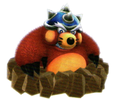
|

|
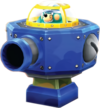
|

| |||||||||||||||
| Bowser's bratty son. He captains a miniature airship that fires Bullet Bills and enflamed cannonballs at Mario. Magikoopas aide Bowser Jr. during the fight. Throwing shells at the airship damages it and eventually makes it sink. Bowser Jr. otherwise has a recurring story presence throughout the game. | A giant Undergrunt endangering a Star Bunny. He burrows towards Mario before bursting from the ground with swiping claws. Performing a Ground Pound on the earth when his head is exposed forces him to the surface and leaves him vulnerable to a spin attack. | A large Ice Bubble. He fires ice balls that freeze Mario on contact. If close, he thrusts himself downward and generates a freezing shockwave. Being close to the ground leaves him vulnerable to being spun. Doing so extinguishes his icy aura. | Cyan Undergrunts that operate a blue rotating cannon. The cannon fires drops of water which push Mario back. The glass-encased cockpit is the weak point. | An enormous tin toy robot modeled after Bowser. Gearmos are trapped inside of its mouth. To free them and destroy the robot, the stack of stone discs on top of its head must be Ground Pounded. | |||||||||||||||
| Missions | Missions | Missions | Missions | Missions | |||||||||||||||
| Sinking the Airships | The Dirty Tricks of Major Burrows Major Burrows's Daredevil Run |
The Frozen Peak of Baron Brrr | When It Rains, It Pours Bubble Blastoff |
Heavy Metal Mecha-Bowser | |||||||||||||||
| Undergrunt Gunner (Electric Bazooka) |
white | King Kaliente (Black) | white | ||||||||||||||||

|

|
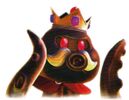
|

| ||||||||||||||||
| A cyan Undergrunt that operate a yellow rotating cannon. The cannon shoots homing balls of electricity that damage Mario. | A massive, skeleton shark that is defended by a school of Bonefins. It is vulnerable to shells. As it swims, it destroys underwater pillars in its path. It does not actively pursue Mario, but it summons more Fish Guards as the battle progresses. | A scorched variation of King Kaliente that becomes aggressive much faster and can summon meteors. | A fast-moving Dino Piranha. Its clubbed tail periodically catches fire. The flames burn Mario and prevent him from spinning the club. After making a successful strike, Fiery Dino Piranha becomes faster; leaves walls of fire in its wake; and spews giant balls of fire. Defeating this boss without being damaged requires well-timed precision. | ||||||||||||||||
| Missions | Missions | Missions | Missions | ||||||||||||||||
| Bouncing Down Cake Lane | Kingfin's Fearsome Waters | King Kaliente's Spicy Return | Fiery Dino Piranha | ||||||||||||||||
Items and objects
Items
| Name | Description | Name | Description |
|---|---|---|---|
 Power Stars |
Objects that are a source of energy for the Comet Observatory. They are stolen by Bowser to create a galaxy of his own at the center of the universe. Collecting them completes missions and unlocks new levels. It is inferred that yellow Lumas can metamorphosize into Power Stars. |  Green Shells |
Shells of green Koopa Troopas. Mario grabs one when he makes contact or spins near it. Shaking |
 Green Power Stars |
Hidden, intermissionary Power Stars. Collecting one attracts a green-colored Luma to the observatory. Collecting all three grants Mario[note 1] access to the Planet of Trials and its Trial Galaxies. The green Lumas become these Power Stars at the end of their lifespans. |  Red Shells |
Shells of red Koopa Troopas. They home-in on nearby targets when thrown. They give Mario a greater speed boost underwater than Green Shells. |
 Red Power Star |
A Power Star affiliated with the Red Star power-up. Only one mission involves this Power Star, and collecting it makes the Red Star available in the Comet Observatory. Red Lumas can become these at the end of their lifespans. |  Gold Shells |
Golden Koopa Shells. They give Mario the greatest speed boost underwater than the other shells. One behaves identically to a Green Shell when thrown by Mario. |
 Silver Stars |
Small Stars that represent one-fifth of a Power Star and are contained in bubbles. Silver Stars squeal like Lumas and trail after Mario when he pops their bubbles. When five are collected, they merge to form a full Power Star. |  1-Up Mushrooms |
Green mushrooms that give Mario an extra life when obtained. They are sold at the Luma Shop. |
 Grand Stars |
Giant Power Stars of considerable energy. They are usually in the possession of bosses. Collecting them makes the beacon expand in size, restores light to the observatory, and unlocks new domes. | Life Mushrooms |
Red mushrooms that doubles the amount of bars in Mario's health meter from three to six. If Mario loses three bars, they cannot be restored. The life meter returns to just three bars when Mario completes the mission, even if at full health. This mushroom is sold at the Luma Shop. |
 Star Bits |
Colorful celestial objects that are eaten by Lumas. They are found floating in space or raining from the sky. They are collected when Mario makes physical contact or when they are touched with the Star Cursor. The Star Cursor works like a reticle: pressing |
Yellow Star Chips |
Star fragments that each represent one-fifth of a Launch Star or Sling Star. Collecting five causes them to merge into either depending on the environmental context. |
 ? Coins |
Big coins with inconsistent properties. Making contact with one has different results depending on the level, but exactly what is not specified until it is touched. One can make a power-up, mushroom, note, or another ? Coin appear. They do not contribute to Mario's coin count. | Blue Star Chips |
Star fragments that represent one-fifth of a Pull Star. Collecting five causes them to transform into one. |
 Coins |
Gold coins. Collecting one restores one bar to Mario's life meter. Collecting fifty during a mission gives Mario an extra life. If Mario loses a life during a mission, he loses all of the coins he collected within that specific mission. | Keys |
Golden collectibles that grant access to new areas. Collecting one opens a corresponding Key Door or glass dome. |
 Purple Coins |
Coins that only appear in a galaxy when Purple Comets are in orbit. Collecting 100 awards Mario with a Power Star. |  Coconuts |
Green fruits. Spinning into one launches them forward like a projectile. Some enemies and bosses fire coconuts themselves. |
 Notes |
Music notes which can appear when Mario touches a ? Coin. They appear in trails in the immediate vicinity and disappear after a few seconds. Collecting every note before they can disappear awards Mario with a power-up, a mushroom, or a Power Star. |  Watermelons |
Alternatives to coconuts that permanently replaces them once Mario accumulates 9999 Star Bits on one save file. |
Power-ups
| Power-up | Effect ( |
Effect ( |
Description |
|---|---|---|---|
 Bee Mushroom |

|

|
Touching the Bee Mushroom transforms Mario into Bee Mario. Holding |
 Rainbow Star |

|

|
Making contact with the Rainbow Star transforms Mario into Rainbow Mario for thirty seconds. He is invincible and can defeat enemies on contact. Running in this form makes Mario build speed and shortens the height of his jump. Attempting to collect a different power-up in this form will instead launch it up without collecting it. |
 Boo Mushroom |

|

|
Mario is transformed into a Boo when he touches the Boo Mushroom. Shaking |
 Ice Flower |

|

|
Contact with the Ice Flower transforms Mario into Ice Mario for thirty seconds. Mario creates hexagonal ice platforms when he makes contact with water or lava. This enables Ice Mario to wall jump between waterfalls. Because he produces ice under his feet, Ice Mario can continuously skate over water and lava. |
 Fire Flower |

|

|
The Fire Flower transforms Mario into Fire Mario for thirty seconds. Shaking |
 Spring Mushroom |

|
Making contact with the Spring Mushroom transforms Mario into Spring Mario. Mario continuously jumps in this form. Pressing | |
 Red Star |

|

|
The Red Star transforms Mario into Flying Mario for sixty seconds. Shaking |
Objects
| Name | Description | |
|---|---|---|
| Transportation objects | ||
 Launch Star |
Floating Stars near the surface of planets that launch Mario to distant areas when spun near. Some yellow Lumas transform into Launch Stars when freed by Mario. | |
 Pull Star |
Floating Stars that are interacted with the Star Cursor. Moving the cursor over a Pull Stars and holding | |
 Sling Star |
Diminutive Launch Star-like objects that sling Mario towards a neighboring planet when spun near. | |
Pipe |
Pipes going through the ground that transport Mario to new areas. He enters one when | |
Warp Pad |
Transport panels that transport Mario along a curved beacon of light from one part of the Comet Observatory to another. More Warp Pads become available as energy is restored to the observatory. They are not in any of the galaxies. | |
 Key Door |
Doors that open when Mario makes contact with a key. | |
 Sproutle Vine |
Twisting vines that sprout from the base of defeated Piranha Plants. Mario grabs and swings up one by spinning. Sproutle Vines enable Mario to travel from one planetoid to another. | |
Cannon |
Cannons that launch Mario to distant areas. They are accessed like pipes. Entering one shifts the screen perspective to inside the cannon and turns to Star Cursor into a reticle symbol. Aiming the cursor on screen and pressing | |
 Bubble |
Big bubbles that are moved by the Star Cursor. Mario becomes trapped inside one when he touches it. The Star Cursor turns into an air-blowing nozzle that pushes the bubble with | |
 Rolling Ball |
Translucent orbs that contain Power Stars. Mario takes control of one when he jumps on top of it. The ball is steered by shifting | |
 Sling Pod |
Clumps of adhesive spider silk. Mario becomes stuck to one when he makes contact with it. Pointing on it with the Star Cursor and holding | |
 Banandelion |
Tall dandelions. Mario grabs onto one by spinning. Continuing to spin makes Mario ascend up the flower like a Sproutle Vine and flings him. | |
Floaty Fluff |
Short dandelions that are carried on gusts of wind. Mario grabs onto one by spinning. It slowly descends as it floats. It ascends briefly by shaking | |
Tornado |
A vortex of desert winds that moves back and forth along a set path. Making contact will trap Mario within its gusts, but this does not damage him. Mario is propelled high into the air like a bamboo-copter if he tries to spin. | |
Swing |
Trapezes made out of vines and flowers. Mario grabs onto one automatically when he makes contact with it. Moving | |
Vine |
A rope swing that Mario will grab onto when he jumps towards it. Moving the | |
| Blocks and containers | ||
 ? Block |
Floating blocks that contain a finite number of items (see above). One releases its content when Mario jumps underneath it. ? Blocks that contain coins and some that have Star Bits can be jumped under in rapid succession to release more than one. Most ? Blocks become empty blocks when there contents are exhausted. There are ? Blocks containing Star Bits that burst immediately when jumped under. Some are invisible and only become viewable once interacted with. | |
 Brick |
Blocks. Some are Coin Blocks that contain multiple coins like ? Blocks. Others are empty and fall apart when jumped under. | |
 Block |
Blocks that contain nothing and cannot be broken. Coin Blocks and some ? Blocks become these when their contents are exhausted. | |
 Crate |
Wooden boxes which rest on the ground. They contain items or Goombas. They release their contents when spun near or ground-pounded, which breaks the Crate. | |
 Treasure chest |
Wooden treasure chests that contain items. One opens when a Koopa Shells is thrown at it. | |
 Gold Treasure Box |
A treasure chest that only opens when struck by a Gold Shell. It contains a Power Star and the Toad Brigade Captain. | |
 Sliding block[26] |
Flat, transparent ? Blocks only found in Gold Leaf Galaxy. They slide across the surface of the planet like hockey pucks and can damage Mario on impact. Breaking one with a ground-pound releases an item. | |
| File:Nocoverart.png Stone block[26] |
A giant block in Rolling Gizmo Galaxy that can be destroyed by ramming it with the Star Ball. | |
| Strikable and spinnable objects | ||
Crystal |
Minerals which are broken when spun into. Most crystals are small, contain Star Bits, and are broken with a single spin. Others are large, contain Power Stars, and require three spins to be broken. | |
Rubbery bulb |
Bulbous plants similar to roly-poly toys. They can be used to break objects and defeat enemies. Spinning into one flings it forward and return with the same force exerted. Mario receives knockback if hit by the rebound. The plants rebound is halted if it collides with an enemy or object. They are comparable to the prickly plant enemies. | |
Snowman |
Snow sculptures. Their positioning within areas obstruct paths. They are destroyed with fireballs. | |
| File:Nocoverart.png Snow mushroom |
Snow sculptures in Snow Cap Galaxy. They are destroyed with fireballs. | |
Bowser Statue |
Stone statues of Bowser which contain items. They are destroyed when they are struck by Bomb Boos or Bullet Bills. | |
Icicle Rock[27] |
Speleothems found on the floors of cave areas. They fall apart when spun into. Some contain items. | |
 Cage |
Glass spheres. They contain objects of interest such as pipes, Star Bits, or Power Stars. In one mission, Luigi is trapped in a cage. They can be broken by Bullet Bills. | |
 Tiny lamp[26] |
A shimmering protrusion in the ground. Firing a Star Bit at one with the Star Cursor transforms it into a collectible coin. | |
   Stone circle[26] / Shell Circle[28] / Strawberry Circle[29] |
A circle of eight objects embedded in the ground. Spinning inside the circle transforms the objects into Star Bits. | |
 Bolt |
Phillips-headed bolts embedded in the ground. Mario screws them into the ground when he spins on top of them. Doing so grants Mario access to new areas or triggers nearby events. | |
 Water Valve |
Variants of the bolt that prevents the flow of water in an area. Spinning on top of one releases the water. | |
| Ground-poundable objects | ||
 Stump |
Tree stumps. Ground-pounding one either produces items or triggers events that enable level progression, like Ground-Pound Switches. | |
 Stone Wheel |
Stone discs. Ground-pounding one breaks it and usually releases an item. Breaking one sometimes changes an element of the area it is in. In some galaxies, they are multiple Stone Wheels stacked on top of each other. | |
 Trampoline |
Springboards which bounce Mario high in the air. Ground-pounding the surface of a trampoline launches Mario higher. | |
| Switches | ||
  Flipswitch Panel |
Blue ? panels that turn into yellow ! ones when Mario steps on them. Stepping on all of the panels in a confined area triggers access to a new area or the appearance of a Power Star. | |
 Lever Switch |
Levers that physically change the surrounding area, usually by granting Mario access to a new area by making a door or bridge appear. Mario uses one by spinning near it. | |
 Ground-Pound Switch |
Buttons that trigger a change in the surrounding environment when Mario ground-pounds into them. A Ground-Pound Switch is only useable once. There are wooden and stone variants that are destroyed when activated, and the symbol on their button's face also appears on the abdomen of Mandibugs. | |
 Blue switch |
Blue ! Switches. Ground-pounding one usually triggers a timed event or changes an element in the area it is encountered. | |
Arrow Switch |
Mounted arrow-shaped levers that shifts the gravitational pull from the floor to the ceiling. They only occur in portions of levels on a two-dimensional plane. | |
| Platforms | ||
 Assembly Block |
Multi-shaped and multicolored block platforms. They initially float distantly in midair, but will immediately assemble into an established configuration if Mario approaches the intended space. They fall away if Mario moves away from the intended space, meaning the player does not have a permanent visual as to where the platforms are going to appear. | |
 Lift |
Moving platforms. Their designs and environmental context for moving depends on where they are encountered. | |
 Flower |
Floating flower platforms that recede if Mario makes contact with them. He can only stand on them while in his bee form. | |
 Shrinking platform |
A checkerboard platform that disappears once Mario stands on it. | |
Cloud |
Floating platforms that Mario is normally too heavy to stand on. He can only do so in his bee form. There are raining gray variants that move along set paths. | |
 Bolt Lift |
Platforms made of three giant nuts on a threaded rod. The rod connects two distant areas. Walking perpendicular to the rod on the nuts makes them rotate, allowing Mario to travel between the areas. | |
 Ice |
Frozen surfaces. Ice reduces Mario's traction and causes him to slide, but spinning causes Mario to start skating. | |
| File:Nocoverart.png Paddle Platform |
A set of four platforms in the form of a windmill in Honeyhive Galaxy that perpetually spin around their pivot point. | |
 Cut-out platform |
Platforms in Sweet Sweet Galaxy with holes that come in different sizes and shapes, which can cause Mario or Luigi to fall. | |
| File:Nocoverart.png Conveyor Belt |
Platforms that carry Mario from another place to another without him moving. | |
| File:Nocoverart.png Track |
Rails that can roll the Star Ball without the player moving it. | |
| File:Nocoverart.png Water lift |
Platforms that sink in water if Mario or Luigi steps on them, then rise back up. | |
| File:Nocoverart.png Steel platform |
Platforms that sink in lava if Mario or Luigi steps on them, then rise back up. | |
| File:Nocoverart.png Volcanic rock platform |
Platforms that sink if Mario or Luigi steps on them. | |
| Other objects | ||
 Ring |
Underwater rings. Swimming through one gives Mario a burst of speed. | |
| File:Nocoverart.png Matter |
Matter can take two forms: bouncing droplets that reveal circular parts of the planet's terrain, and spotlights that move in a set path revealing parts of the planet in their range. | |
| File:Nocoverart.png Fan |
Produces constant gusts of wind. | |
Pole |
Climbable poles. Mario clings to one by jumping onto it. He can ascend, descend, and change which face of the pole he is on by moving | |
 Honey wall |
Hexagonal panels attached to the side of walls within levels. Mario can cling and crawl on them, but only while in his bee form. | |
 Bob-omb dispenser |
Depositories that release Bob-ombs. A single dispenser only releases one Bob-omb at a time: the current one out must explode before it releases another one. The Bob-ombs are usually active, but the Bob-omb dispensers in the Bob-omb Blasting minigame only release the legless variants that can be picked up by Mario. | |
 Ring[26] |
Indentations in the ground for the Rolling Ball. The yellow rings launch the Rolling Ball from one planetoid to another. The blue ones are the final goals for the levels. They break the Rolling Ball and allow Mario to collect its Power Star. | |
 Water spigot[26] |
A device that expels water into the air in timed intervals. Mario is briefly carried into the air when he enters the stream. When in his ice form, Mario can freeze the surface of the water to form temporary ice platforms. | |
 Nail |
Metal rods embedded in the caverns of Deep Dark Galaxy. Mario can swing from them like trapezes to reach higher areas. | |
 Soft snow |
Terrain in Snow Cap Galaxy that slows down Mario's and Luigi's speed. It can be erased by using the Star Cursor. | |
| File:Nocoverart.png Bush |
Plants that Mario or Luigi can walk through. Some may contain Star Bits or Coins. | |
| File:Nocoverart.png Flowerbed |
Plants that Mario or Luigi can walk through. Some may contain Star Bits or Coins. | |
| File:Nocoverart.png Gravity ramp |
A wall-mounted ramp that can switch Mario's gravitational pull by walking across it. | |
| File:Nocoverart.png Meat |
A bumper-like piece of meat in Ghostly Galaxy's Spooky Speedster course that bounces Mario away. | |
| File:Nocoverart.png Bone |
An obstacle in Ghostly Galaxy's Spooky Speedster course that can hinder Mario's path. | |
| File:Nocoverart.png Rotating wall |
A wall in Bubble Blast Galaxy that can hinder Mario's path. | |
| File:Nocoverart.png Iron die |
A large, indestructible block of iron in Rolling Gizmo Galaxy that can either push Mario off or block his path. | |
 Board |
Posted signs that contain information on actions. Several of them are speaking characters that give Mario specific instructions on how to use objects or power-ups that change how he is controlled. | |
Beacon |
The comet at the center of the Comet Observatory that gives it its energy. Collected Power Stars are fed to it. Grand Stars make it grow larger and unlocks new areas of the observatory to explore. | |
Letters
At various points in the game, the Mailtoad gives the player a letter, which is sent to the Wii Message Board.
Whenever Luigi needs to be rescued after initially saving him from the Ghostly Galaxy, the letter says the following:
Dear Mario,
Oh, no! It's horrible!
Luigi has gone missing!
What will we do?!
Mailtoad
After rescuing Luigi each of these times, the letter says the following:
Dear Mario,
Thank you for saving Luigi! Keep trying to rescue those Power Stars, and we'll do our best to help! ♪
Mailtoad
After getting the 121st and final Power Star from the Grand Finale Galaxy, the letter will say the following:
Dear (Mii's name),
Congratulations! We would like to send you a galaxy sized thanks for saving all the Power Stars and playing to the very end.
Until next time;
The Super Mario Galaxy staff
Quotes
- Main article: List of Super Mario Galaxy quotes
Bowser
- "Princess Peach! You are formally invited...to the creation of my new galaxy! Gwahahaha! This festival's over!"
- "BWAHAHAHA! You finally made it! Just in time for me to stomp you into space bits!"
- "WHAA--?! IT'S YOU! That's it, Mario! I'm gonna stomp you into space bits!"
- "Finally! You got here just in time to see the creation of my galaxy in the center of the universe! WATCH AND WEEP! From this galaxy, I'll rule a great galactic empire with Peach by my side. It will last forever! I will rule every pitiful corner of the universe. So, Mario, as you can see, I got big plans. And stomping you is at the top of my list!"
- "NOOOOO! My galaxy! My empire! This can't be happening..."
Queen Bee
- "And who might you be? A physician, we presume? No matter. We are in the most vexing predicament and require assistance. The most furious itchiness plagues our entire being! It must be stopped! Please find the source at once!"
- "Yes that's the ticket!"
- "Ah...that feels goooood!"
- "Ahoo hoo! That tickles!"
- "My thanks! You have shown much bravery, New Bee. We trust that we may rely on you in the future!"
- "The neighbors are causing trouble again. We would be most grateful for your assistance!"
Music
- Main article: Super Mario Galaxy Original Soundtrack
A soundtrack for the game was released called the Super Mario Galaxy Original Soundtrack. There is a one-disc edition and a two-disc Platinum edition. It was exclusive to Club Nintendo members in Japan and Europe. The one-disc version was also included in certain bundles of the Wii in 2010 that also contained Wii Sports and New Super Mario Bros. Wii.
Media
- For a complete list of media for this subject, see List of Super Mario Galaxy media.
| File info 3:12 |
| File info 0:30 |
| File info 0:30 |
Staff
- Main article: List of Super Mario Galaxy staff
A team of 100 individuals were involved in the development and publishing of Super Mario Galaxy, not counting those who merely localized the game for American and European audiences. The game's diverse staff ranged from Mario franchise veterans to newcomers.
Shigeru Miyamoto conceived the game and was its co-producer with Takao Shimizu. Yoshiaki Koizumi was the director and chief designer. The level design was directed by Koichi Hayashida, the programming by Naoki Koga, and the sound by Masafumi Kawamura. Characters original to the game were designed by a team of six people — Atsushi Mishima, Daisuke Watanabe, Rikuto Yoshida, Masanori Esaki, Kazuhiro Saito, and Takumi Ishii. Koji Kondo co-wrote the game's soundtrack with Mahito Yokota.
This is the first Super Mario game to feature Bowser's current voice actor, Kenny James.
The staff credits in the Nvidia Shield edition shows three people in charge of Chinese localization, as well as an "iQue testing group" for testing. It is possible that the game was fully translated for the iQue Wii release before the console was canceled.[30]
Development
Super Mario Galaxy finds its roots in the Super Mario 128 demo.[16] Yoshiaki Koizumi, the director of the demo, wanted the part where Mario moves freely around a saucer-shaped platform to be included in an actual game, but found that implementing the concept would be technically demanding.[16] Shigeru Miyamoto remained interested in the concept, and after Donkey Kong Jungle Beat's completion, asked the newly formed EAD Tokyo if they wanted to make a high-profile game starring established Nintendo characters, which led to one of the staff member suggesting that they had the skillset to make a Mario game.[16] Yoshiaki Koizumi felt that the Jungle Beat team had the ability to make spherical platforms work and said that he wanted to make the game for the Wii.
Koizumi then gathered several other members in order to create a prototype. The outer space theme was chosen due to him finding that most players would interpret spherical shapes as planets, and gravity was added.[16] The prototype was shown to Nintendo after three months of development, which approved it. During the development, the team tried to follow loose guidance from Satoru Iwata to make the game playable for anyone between ages "5 and 95".[16]
Although Miyamoto was not working full time at EAD Tokyo, he frequently visited the studio to share ideas and oversee development. One of his suggestions was to include a delay between spinning instead of having Mario spin continuously by shaking the Wii Remote, so that the game would be more challenging and interesting to play.[16] A setup was eventually created so that both the Kyoto and Tokyo offices could playtest the game.
The development team made heavy use of play-testers due to the studio's experience while developing Donkey Kong Jungle Beat.[16] One of Koizumi's main concern were the camera angles and the motion sickness that they caused. He thought camera-induced motion sickness was a problem with 3D action games, and found neither Super Mario Sunshine nor Donkey Kong Jungle Beat's solutions satisfying.[16]
EAD Tokyo was pressured to finish the game close to the Wii's launch, as several executives were disappointed by Super Mario Sunshine not being a Nintendo GameCube launch title and thought that an earlier release could have helped the GameCube's commercial performance. However, EAD Tokyo decided that making a polished Mario game was more important.[16] Shigeru Miyamoto described Super Mario Galaxy as "the true sequel to Super Mario 64" during the game's development.[19]
Pre-release and unused content
Rosalina was intended to be related to Princess Peach, and Rosalina had a very similar appearance reflecting this. Bonefin Galaxy was intended to be much darker, as was Deep Dark Galaxy. These were changed in the interest of playability. Guppy was originally a dolphin, and a friendly character. Some art of the Sea Slide and Beach Bowl Galaxies suggests that they were conceived as a single galaxy, with beach bowl's main planet in the center of Sea Slide's ring. A piece of concept art labeled only "fortress" is captioned as a piece that is very memorable to the SMG development team, since it was one of the earliest drawings of Galaxy. Ironically, the planet shown in the art is nowhere in the final game.
Glitches
- Main article: List of Super Mario Galaxy glitches
Floating Toad
To perform this glitch, the player should go to the level Tarantox's Tangled Web. Mario should go to the final planet where Tarantox is fought and launch the green Toad onto the platform. Then, the player should jump into the sling pod and launch Mario onto the same platform so it breaks. If the player looks at Toad closely, he can be seen floating.
Out of bounds in Freezeflame Galaxy
To perform this glitch the player should go to the Freezeflame Galaxy's mission Hot and Cold Collide. Mario should reach the second planet and triple-jump in the walkway between the sides of the planet. The player should use the slope-climbing glitch to reach the top of the planet. When the player walks on the planet, random textures of ice water will appear. The planet surface will also appear in the wrong spot or be invisible.
Promotion
- Main article: List of Super Mario Galaxy trading cards
Trading cards were released to celebrate the release of Super Mario Galaxy. These helped amplify the publicity of the game. Each booster pack would have two regular cards, one trivia card, one standee, and one FunTat.
Reception
Super Mario Galaxy has been met with universal acclaim, receiving a GameRankings score of 97.64% from 78 reviews,[31] making it the highest rated game on the website, while scoring a 97/100 on Metacritic,[32] as of March 2019 the sixth-highest score on the latter website.
Famitsu has given Super Mario Galaxy a score of 38/40.[33][34] Official Nintendo Magazine gave the game 97%. It was called the best game of the decade and praised for having excellent graphics, sound and gameplay as well as a mixture of new and classic features.[35][36]
| Reviews | |||
|---|---|---|---|
| Release | Reviewer, Publication | Score | Comment |
| Wii | Aaron Linde, Destructoid | 9.6/10 | "To say that they've succeeded almost isn't enough; Super Mario Galaxy is so incredible that it improves upon flaws in Mario 64 that I hadn't even noticed until, y'know, Galaxy did it better. And though there's little in the way of "innovation" of the genre, it's the refinement of the genre that solidifies Galaxy as the most essential platforming experience yet created." |
| Wii | Edge | 10/10 | "Since the end of the N64 era, as Nintendo has explored new pastures and methodically tended old ones, it's been easy to forget the times when every major release from the company felt like this. It's a bravura piece of design that pulls off stunts no one else has even thought of." |
| Wii | Margaret Robertson, Eurogamer | 10/10 | "The great challenge in making a follow-up to Mario 64 was always that to do it justice, you'd have to make a game which is as much its own as Mario 64 was. That's no easy task when you also have to integrate the traditions of two decades of Mario games and the expectations of millions of fans. Sunshine, despite its dazzle, ultimately collapsed under that weight, becoming repetitive and sometimes cumbersome as it tried to find the balance. Where Galaxy matches Mario 64 is not quite in its quality of execution - alongside the brilliance of some stars are others which fall a bit flat, and there isn't the overall sense of implacable perfection that that game had - but in its confidence and originality. Another decade needs to go by before we'll know whether it will come to be as revered as 64 did. For now, all that matters is that the waiting is finally over." |
| Wii | Alex Navarro, GameSpot | 9.5/10 | "The stellar presentation and fantastic level designs combine to make Super Mario Galaxy the Wii's game to beat and one of Mario's greatest adventures yet." |
| Wii | Matt Casamassina, IGN | 9.7/10 | "Galaxy isn't quite perfect. There are some minor issues -- tiny blemishes, if you will, hiding on the backside of a supermodel. There's the auto-camera, which works exceptionally well most of the time, but every so often stumbles. And there's the overall difficulty -- a little too easy to 60 stars and to defeat bosses for my tastes. But even with these potential drawbacks, Nintendo's Tokyo studio has created a platformer that deserves its place among the very best and will surely be remembered in another decade as a classic." |
| Wii | Anthony Dickens, Nintendo Life | 10/10 | "Super Mario Galaxy is a fantastic game, a game that displays Nintendo's continuing ambition to explore the possibilities of a 3D platformer, something that no-one else has really managed to do. It's considerably better than Super Mario Sunshine on all accounts, with the new emphasis on gravity it becomes once again a game that requires skill and timing rather than just an exploratory mind. This will be an instant hit and surely go down as one of the best Mario games. A must have for all." |
| Wii | Tom Orry, VideoGamer | 9/10 | "In the hands of anyone who's been longing for a true sequel to Mario 64, Super Mario Galaxy could well be the game of the year, but it's nowhere near as revolutionary as Mario 64." |
| Aggregators | |||
| Compiler | Platform / Score | ||
| Metacritic | 97 | ||
| GameRankings | 97.64% | ||
Awards and recognition
Super Mario Galaxy is considered regarded as 2007's "Game of the Year" by editing staff of IGN,[37] GameSpot,[38] Kotaku,[39] and Yahoo! Games.[40]
In 2007, the game won an award for "Best Audio Design" from Edge.[41] In February 2008, the game received the "Adventure Game of the Year" award from the Academy of Interactive Arts & Sciences at the Interactive Achievement Awards.[42]
In 2009, the game won "Best Game" at the 5th British Academy Games Awards.[43] That same year, Guinness World Records ranked Super Mario Galaxy 29th in their list of top 50 console games of all time based on initial impact and lasting legacy.[44]
The game placed 51st in the 200th Issue of GameInformer's "Top 200 Games of All Time".[45] Nintendo Power ranked it as best Mario mainstream title in its May 2012 issue,[46] as well as the third-best game ever released on a Nintendo console in its final issue.
Sales
Super Mario Galaxy has been a commercial success, selling 350,000 units in Japan within its first few weeks of sale.[47] In the United States, the game sold 500,000 units within its first week of release, earning it the highest first-week sales for a Mario game in the country at the time.[48] Super Mario Galaxy is the 8th best-selling game for the Wii, selling 12.72 million copies worldwide as of September 2017.[5] As of September 30, 2021, it sold 12.80 million copies worldwide.[49]
Controversy
Super Mario Galaxy was the first Mario game to be officially localized to French for Quebec; that market had previously received Mario titles in English rather than French. This followed a deal between the Office québécois de la langue française and the video game industry to have every game available for that region in French by 2009. In the Quebec localization, NPCs (particularly the Lumas and the Toad Brigade) make heavy use of Joual accents and slang. This localization choice sparked a minor controversy, with representatives of the Office québécois de la langue française and the Union des artistes criticizing it for promoting poor literacy to children.[50] A Nintendo representative responded that the localization was made with "localizing for the market" in mind, as the Quebec market made up 25% of sales for Nintendo of Canada at the time.[50]
Following the negative reception to the localizations of Super Mario Galaxy and The Legend of Zelda: Phantom Hourglass (which featured a similarly Joual-heavy localization), later Canadian French localizations would be written in Standard French (with the exception of the similarly-localized Paper Mario: Sticker Star).
Nvidia Shield version
The game was released in March 22, 2018 for the Nvidia Shield video game service, exclusively in China. While the majority of the game is exactly the same as the Wii version, it comes with some differences:
- The Nvidia Shield version received official Chinese (Simplified Chinese) localization by iQue. Despite this, the Super Mario 3D All-Stars does not include Chinese script in-game and only offers menu translation for the Chinese-speaking audience.
- The Nvidia Shield version shows copyright information "© 2007-2008 Nintendo". It was unknown what 2008 means in this context, but it possibly refers to the year Super Mario Galaxy was planned for release on the iQue Wii before the console failed to make its way into the Chinese market.[51]
- The Nvidia Shield version lacks the option to use Miis as a save icon because the Nvidia Shield TV does not support Miis.[51] This change is carried over to the Super Mario 3D All-Stars version even though the Nintendo Switch has an integrated Mii creation tool.
Super Mario 3D All-Stars description
- It's the night of the Star Festival, and Star Bits are falling from the sky! As everyone celebrates, Bowser suddenly appears and lifts the castle—and Princess Peach—into space, leaving Mario stranded in orbit! It's here that Mario meets a curious star child, Luma, and a mysterious woman in blue...This game introduced new ways to control Mario, like pointing and shaking the Wii Remote, as he explores miniature planets with fun forms of gravity.
References to other games
- Super Mario Bros.: Several sprites from this game appear here, including a planet in the Toy Time Galaxy, Mario sprites being in the background of a particular Bowser galaxy, and the background of the Flipswitch Galaxy which has scenery of the overworld and underground levels. Also, Toy Time Galaxy's music is a rearrangement of the overworld theme from this game. Several galaxies use a remix of a small portion of the underground theme from this game. Also, an arrangement of the underground theme is used for several galaxies, starting with Flipswitch Galaxy. Some of the musical notes are music from the game such as the underground theme and the underwater theme.
- Super Mario Bros.: The Lost Levels: Luigi's higher jumping and lower traction returns.
- Super Mario Bros. 3: Several music tracks from this game are rearranged here. Airships also return.
- Dr. Mario: A planet in Good Egg Galaxy is shaped like a giant Capsule from the aforementioned game.
- Super Mario World 2: Yoshi's Island: Rainbow Mario's theme is an orchestral remix of Superstar Mario's theme from this game.
- Pokémon series: A planet in Buoy Base Galaxy is shaped like a Poké Ball.
- Super Mario 64: Tox Boxes and Bomps from this game return. The music of some Bowser galaxies are rearranged from Super Mario 64. In both games, after the credits and an ending screen is displayed, Mario would say "Thank you so much for playing my game!".
- Paper Mario: Both games begin with a letter being sent from Peach to Mario. Also, Bowser's way of kidnapping Peach (by lifting the entire castle into the sky) is reused here. They also have stories of baby stars.
- Luigi's Mansion: When the player first sees Luigi, he is trapped in a Ghost House. Mario freeing him is a direct spoof of Luigi's Mansion, as in Luigi's Mansion it was the direct opposite. Also, some of Luigi's voice clips are recycled.
- Super Mario Sunshine: Fire Shooters and Water Shooters, which appear in various galaxies, have a strong resemblance to FLUDD's nozzle. The goal in the Loopdeeloop Galaxy and the Loopdeeswoop Galaxy is also shaped in a Shine Sprite. Blue Cataquacks are present in two galaxies. Also, while Mario or Luigi is asleep, they have Z's flashing over their head, just like in the game. The sparkling sound a Shine Sprite makes was reused for the same purpose for Power Stars in Super Mario Galaxy.
- Super Mario 64 DS: The Silver Stars from this game return in Super Mario Galaxy.
- Donkey Kong Jungle Beat: The Banandelions that Donkey Kong flings off of were reused in Super Mario Galaxy.
- Mario Party 7: If a Dry Bones falls into quicksand in Dusty Dune Galaxy, the cry Dry Bones makes when it is "blown away" in these games can be heard.
References in later games
- Super Smash Bros. Brawl: Super Mario Galaxy appears listed in the game's Chronicles.
- Mario Kart Wii: Rosalina can be unlocked by having save data from Super Mario Galaxy. The Rainbow Road course is set in space and is full of Star Bits; a portion of its music is based on the Good Egg Galaxy's theme. Spiky Topmen were bosses in multiple online tournaments, and finally, the countdown sequence for starting a minigame returns as the official sequence for starting races and battles in this game.
- Mario & Luigi: Bowser's Inside Story: The Spike Ball move used by Bowser in the last boss fight returns in this game.
- Mario & Sonic at the Olympic Winter Games (Wii): Both the Individual and Team versions of Dream Ski Jumping take place in the Good Egg Galaxy. A few music tracks from Super Mario Galaxy can be bought.
- New Super Mario Bros. Wii: During the credits, Peach can be heard reading the letter she sends to Mario at the beginning of Super Mario Galaxy.
- Super Mario Galaxy 2: This is the sequel to Super Mario Galaxy with the engine reused, with many elements returning such as the reused voices, while others are new.
- Super Mario 3D Land: The haunted house theme and the arrangement of the Airship Theme are reused. Several other music tracks and voice clips from Super Mario Galaxy were reused for this game.
- Mario & Sonic at the London 2012 Olympic Games: Dream Spacewalk is heavily inspired by Super Mario Galaxy, featuring Dino Piranha as a boss in the Synchro Battle Galaxy, a location based on elements of the Good Egg Galaxy and Gateway Galaxy as well as the Sky Station Galaxy from Super Mario Galaxy 2. The event also features sound effects from Super Mario Galaxy and uses the spin attack in combat. Dream Hurdles takes place in the Battlerock Galaxy. Rearrangements of several tracks appear in the game, including Dino Piranha's theme, the Battlerock Galaxy and the Purple Coins music. A Mii outfit based on Bee Mario can be unlocked in the game, and Mario's special dash has also been updated to resemble the spin attack.
- Mario Kart 7: On the Rosalina's Ice World course, the Comet Observatory, the Gateway Galaxy's starting planet, the Starshroom, and some domes are visible in the background. Queen Bee can be unlocked as a playable character in this game.
- Mario Party 9: The Ground-Pound Switch icon appears on Wiggler's body segments and on Whomp's back. Also, the music of some Bowser Jr. minigames is a rearrangement of Bowser Jr.'s theme of this game.
- Mario Tennis Open: The Comet Observatory appears as an unlockable court. The music played is an arrangement of the original theme and the music for the special game Galaxy Rally is an arrangement of the Good Egg Galaxy theme. Also, in the title screen, the player can see the Comet Observatory in the background.
- Paper Mario: Sticker Star: An arrangement of "Waltz of the Boos" plays in part of the Enigmansion's background music. Another, big-band-styled version plays when the Boos escape from the Book of Sealing.
- Mario Party: Island Tour: Rocket Road is based on the Comet Observatory. Also, Rosalina and the Lumas appear on this board. The minigame Gyro for the Gold plays very similarly to the Rolling Ball.
- Super Mario 3D World: There are secret underground rooms where the player can collect sequences of coins for a limited time and receive a prize if all coins are collected. In the promotional spread, a silhouette which appears to be the Comet Observatory can be seen in the stars behind Bowser's Highway. The Light Boxes' light can defeat ghosts like in this game. Rosalina's special ability is the spinning ability Mario uses. Super Galaxy, a stage based off of the Super Mario Galaxy games appears, and so do Octoombas and the Comet Observatory. The Comet Observatory theme (3rd version) plays in the World Crown map area, while an arrangement of Gusty Garden Galaxy's theme can be heard in Honeycomb Starway, Honeycomb Skyway, and Champion's Road. The overworld map of World Star has Star Bits in the background. Also, the Toad Brigade theme is reused on the Captain Toad levels. Also, sound effects from Super Mario Galaxy are reused.
- Mario Golf: World Tour: Mario's Star uses elements from Super Mario Galaxy such as Star Bits. The music used in Wiggler Park uses a rearrangement of Honeyhive Galaxy's music.
- Mario Kart 8: An image of a Luma can be seen from an airplane (from Galaxy Air airlines) at the Sunshine Airport course, as well as on the Star Cup trophy. Also, part of Cloudtop Cruise's music is an arrangement of Gusty Garden Galaxy's music.
- Super Smash Bros. for Wii U: There is a stage based on this game and Super Mario Galaxy 2, with the Starship Mario and Airship appearing in the background of the main stage. Rosalina is playable in this game, and her moves use objects from Super Mario Galaxy, such as Star Bits and Launch Stars.
- Puzzle & Dragons: Super Mario Bros. Edition: Mario's Bee and Boo forms appear in this game as Helpers for the player's team, as well as Rosalina. Gusty Garden Galaxy's music is used for this game's credits.
- Super Mario Maker: The victory and death themes from Super Mario Galaxy are used when the Rosalina costume completes a level or loses a life, respectively.
- Mario Party: Star Rush: Gusty Garden Galaxy's theme appears as one of the songs in the Rhythm Recital mode for this game.[52]
- Mario + Rabbids Kingdom Battle: Bee Mushrooms can be found on tubes of honey. Peach shouting for Mario from this game can be heard whenever she is defeated in battle.
- Super Mario Odyssey: A sprite of Rosalina can be found in the Dark Side and Darker Side. The jingle that plays when Mario collects a new power-up is reused for when the Odyssey is restored. Peach's call to Mario from this game is heard during the opening sequence after Mario is knocked off of Bowser's airship, but in a higher pitch. The regional coins in the Moon Kingdom are based on the shape of Star Bits.
- Super Smash Bros. Ultimate: The Mario Galaxy stage returns in this game. Boo Mario, Luma, Hungry Luma, and Queen Bee appears as spirits using their artwork from Super Mario Galaxy.
- Super Mario Maker 2: A sound effect that plays Gusty Garden Galaxy's theme is available.
- Mario Kart Tour: Super Mario Galaxy's version of Ice Mario appears as a playable driver, Wii Rainbow Road and 3DS Rosalina's Ice World return as classic courses.
- Mario + Rabbids Sparks of Hope: An arrangement of the Comet Observatory theme, "Rosalina in the Observatory", can be heard during Rabbid Rosalina's first appearance in the game's trailer.
Gallery
- For this subject's image gallery, see Gallery:Super Mario Galaxy.
Mario floating with a blue Luma
Concept art of the Toad Brigade in their Starshroom
Illustration from chapter 9 of Rosalina's Story
Names in other languages
| Language | Name | Meaning | Notes |
|---|---|---|---|
| Japanese | スーパーマリオギャラクシー[?] Sūpā Mario Gyarakushī |
Super Mario Galaxy | |
| Chinese (simplified) | 超级马力欧银河[55] Chāojí Mǎlìōu Yínhé |
Super Mario Galaxy | |
| Chinese (traditional) | 超級瑪利歐銀河[54] Chāojí Mǎlìōu Yínhé |
Super Mario Galaxy | |
| Korean | 슈퍼 마리오 Wii 갤럭시 어드벤처[53] Syupeo Mario Wii Gaelleoksi Eodeubencheo |
Super Mario Wii: Galaxy Adventure |
Trivia
- Coincidentally, the title "Super Mario Galaxy" was first mentioned in a fan letter written to Nintendo Power by Jimmy Peterford of Glen Cove, New York in December 1991. The letter detailed a fantasy game console called the "Raw Power System", which would come bundled with a game named "Super Mario Galaxy", or in Peterford's words, would be "better known as Super Mario Bros. 24!"[56]
- An automated phone message sent to people who preordered the game at GameStop stated Super Mario Galaxy is a Mature-rated game.[57]
- The galaxy image in the Super Mario Galaxy wordmark derives from this photograph of the Andromeda Galaxy.[58][59]
- Super Mario Galaxy is an established model in neurobiology for studies investigating how consistent engagement with interactive stimuli affects grey matter in elderly people.[60][61]
- This game does not have a Dutch localization. Despite this, one single message in the game was translated, being the prompt to insert the Nunchuck into the Wii Remote.
Notes and references
Notes
References
- ^ 浪玩堂. "英伟达全球副总裁,中国区总经理张建中先生在现场为我们介绍国行英伟达SHIELD的最新消息,来看看他的游戏阵容!任天堂Wii上游戏将在SHIELD上与我们见面!", (archived from the original; Chinese source). Weibo. Sina Corp. Published 05 Dec 2017. Accessed 21 Mar 2021.
- ^ Kazuya Sakai (Ambit), kikai, Akinori Sao, Junko Fukuda, Kunio Takayama, and Ko Nakahara (Shogakukan) (ed.). Encyclopedia Super Mario Bros. Milwaulkie: Dark Horse Books, 2018. ISBN: 978-4-09-106569-8.
- ^ a b Nintendo. "Nintendo Switch Presentation 2017". YouTube. Published 17 Jan 2017. Accessed 30 Jan 2021.
- ^ a b Bill Trinen. "What's in a Box?". Nintendo Treehouse Log. Tumblr. Published 14 Jun 2017. Accessed 30 Jan 2021.
- ^ a b Nintendo. "Top Selling Software Sales Units".Nintendo. Published 31 Mar 2020. Accessed 06 Mar 2021.
- ^ Nintendo. "Super Mario Bros. 35th Anniversary Direct". YouTube. Published 03 Sep 2020. Accessed 03 Sep 2020.
- ^ Cremin C. (2012). "The Formal Qualities of the Video Game: An Exploration of Super Mario Galaxy With Gilles Deleuze". Games and Culture, 7(1), 72–86. https://doi.org/10.1177/1555412012440309
- ^ Polygon Staff. "The 500 Best Video Games of All Time". Polygon. Vox Media. Published 27 Nov 2017. Archived from the original on 03 Mar 2018. Accessed 30 Dec 2022.
- ^ TV Asahi staff. "国民5万人がガチ投票!テレビゲーム総選挙" (Japanese source). Presented by Kazuki Sawamura. TV Game Sousenkyo (乃木坂46 賀喜遥香). TV Asahi. Aired 27 Dec 2021. Archived by チャンネル. YouTube. Published 16 Mar 2022. Accessed 30 Dec 2022.
- ^ Brian Ashcraft. "Poll: Here Are Japan's Top 100 Video Games Of All Time". Kotaku. Gawker Media. Published 28 Dec 2021. Accessed 30 Dec 2022.
- ^ Juliusaurus. "Super Mario Galaxy Co-op Fun: Midair Jumps". YouTube. Published 04 Jan 2009. Accessed 06 Mar 2021.
- ^ リンカー. "スーパーマリオギャラクシーを実況プレイ Part52" (Japanese source). YouTube. Published 06 Oct 2011. Accessed 27 Oct 2019.
- ^ Chinese Nintendo. "For some reasons, the A button when choosing a Galaxy has been bound to RT instead of A. (The second image is the same text from the original English release)". Twitter. Published 24 Mar 2018. Accessed 06 Mar 2021.
- ^ Chinese Nintendo. "And yes, tilting in Super Mario Galaxy has been replaced by simply the left analog stick on Nvidia Shield". Twitter. Published 19 Jul 2018. Accessed 06 Mar 2021.
- ^ ドラガリキノピコ. "スーパーマリオギャラクシー Part2 ワールド2 バスルーム" (Japanese source of Chinese footage). YouTube. Published 21 Jun 2018. Accessed 06 Mar 2021.
- ^ a b c d e f g h i j k Satoru Iwata (trans. Nintendo Treehouse). "Wii interviews: Super Mario Galaxy". Iwata Asks. Published 2007. Accessed 07 March 2012.
- ^ a b c Yoshiaki Koizumi. "Super Mario Galaxy: The Journey from Garden to Galaxy". Montreal International Games Summit (archived), Jan. 2007. Recorded by Eric St-Cyr. Compiled by Hover. YouTube. Published 24 Sep 2016. Accessed 27 Feb 2021.
- ^ a b c d Michael `Jasper` Ashworth. "How Spherical Planets Bent the Rules in Super Mario Galaxy". YouTube. Published 29 Sep 2020. Accessed 27 Feb 2021.
- ^ a b c d Chris Kohler. "Interview: Super Mario Galaxy Director On Sneaking Stories Past Miyamoto". Wired. Published 04 Dec 2007. Accessed 27 Feb 2021.
- ^ a b c Jacob Geller. "The Quiet Sadness of Mario Galaxy". YouTube. Published 15 Feb 2019. Accessed 30 Jan 2021.
- ^ a b Ruben Aize Meintema. "Planets as small as your house: A review of Super Mario Galaxy". Eludamos: Journal for Computer Game Culture. 4(1). 125 – 128. Published 2010. Accessed 28 Feb 2021.
- ^ Nintendo EAD (trans. Nintendo Treehouse). "Luigi was kidnapped by the monster that lives here." – Toad Brigade Captain. "Beware of Bouldergeist". Super Mario Galaxy. Published Nov 12, 2007. Retrieved Mar 02, 2021.
- ^ Super Mario Galaxy internal filename (ObjectData/KoopaVS3DryIcePlanet.arc)
- ^ Super Mario Galaxy internal filename (ObjectData/ElectricBall.arc)
- ^ Super Mario Galaxy internal filename (ObjectData/LavaMiniSunPlanet.arc)
- ^ a b c d e f Fletcher Black. Super Mario Galaxy: PRIMA Official Game Guide (Collector's Edition). Roseville: Prima Games, 2007. ISBN: 978-0-76155-713-5.
- ^ Super Mario Galaxy / Super Mario Galaxy 2 internal filename (ObjectData/IcicleRock.arc)
- ^ Super Mario Galaxy internal filename (ObjectData/CircleShell.arc)
- ^ Super Mario Galaxy internal filename (ObjectData/CircleStrawberry.arc)
- ^ Chinese Nintendo. "iQue appears in the credits of Super Mario Galaxy on Nvidia Shield. It seemed that the game was fully translated for the iQue Wii release before the console was cancelled". Twitter. Published 01 Apr 2018. Accessed 21 Mar 2021.
- ^ GameRankings score of Super Mario Galaxy. GameRankings. Archived from the original on December 6, 2019. Retrieved March 3, 2019.
- ^ Metacritic score of Super Mario Galaxy. Metacritic. Retrieved March 3, 2019.
- ^ Review staff. "スーパーマリオギャラクシーのレビュー・評価・感想" (Japanese source). Weekly Famitsu. Tokyo: Enterbrain (986). Published Oct 2007. Accessed 21 Mar 2021.
- ^ Anthony Dickens. "Famitsu Gives Super Mario Galaxy 38/40". Nintendo Life. Published 24 Oct 2007. Accessed 21 Mar 2021.
- ^ Chris Scullion. "Super Mario Galaxy review". Official Nintendo Magazine (archived from the original). Bath: Future plc (23): 72–77. Published Dec 2007. Accessed 21 Mar 2021.
- ^ James Higginbotham. "Nintendo Magazine UK: Super Mario Galaxy Review". Pure Nintendo. Published 2007. Accessed 21 Mar 2021.
- ^ Ziff Davis. "IGN Best of 2007" (archived from the original). IGN. Published 13 January 2008. Accessed 21 Mar 2021.
- ^ Editing staff. "GameSpot's Best of 2007" (archived from the original). GameSpot. Published 2007. Accessed 21 Mar. 2021.
- ^ Brian Crecente. "Kotaku's Overall Game of the Year – 2007 Goaties" (archived from the original). Kotaku. Gawker Media. Published 28 Dec 2007. Accessed 21 Mar 2021.
- ^ Editing staff. "Yahoo Games: Game of the Year 2007" (archived from the original). Yahoo! Games. Published 24 Dec 2007. Accessed 21 Mar 2021.
- ^ Edge Staff. "THE EDGE AWARDS 2007" (archived from the original). Edge. Published 20 Dec 2007. Accessed 21 Mar 2021.
- ^ Nintendo of America. "Did You Know? Nintendo Wins Two Interactive Achievement Awards" (archived from the original). Nintendo. Published 08 Feb 2008. Accessed 21 Mar 2021.
- ^ Randy Nelson. "Super Mario Galaxy voted 'best game' by BAFTA". Engadget. Verizon Media. Published 11 Mar 2009. Accessed 21 Mar 2021.
- ^ Tom Ivan. "News: Guinness ranks top 50 games of all time" (archived from the original). Computer and Video Games (CVG). Published 28 Feb 2009. Accessed 21 Mar 2021.
- ^ dantebk. "Game Informer's Top 200 Games of All Time". Giant Bomb. Red Ventures. Published 2011. Accessed 21 Mar 2021.
- ^ Reggie White Jr. "Nintendo Power Ranks the Super Mario Series". GAMING ROCKS ON. Blogger. Published 18 May 2012. Accessed 21 Mar 2021.
- ^ Writing staff. "Super Mario Galaxy Makes Sales Splash In America". Wired. Published Nov 2007. Accessed 21 Mar 2021.
- ^ Mark Raby. "Super Mario Galaxy sees record first week sales". Tom's Hardware. Published 27 Nov 2007. Accessed 21 Mar 2021.
- ^ Nintendo (November 4, 2021) Top Selling Title Sales Unites. Nintendo Japan. Retrieved November 8, 2021. Archived from the original on November 8, 2021.
- ^ a b Marie-Joëlle Parent. "Nouveaux jeux Nintendo: un français lamentable" (archived from the original; French source). Canoë. Published 08 Nov 2007. Accessed 21 Mar 2021.
- ^ a b Chinese Nintendo. "Super Mario Galaxy (Nvidia Shield) screenshots. Images provided by @brian02031". Twitter. Published 24 Mar 2018. Accessed 15 Mar 2021.
- ^ NintenDaan. "[Mario Party: Star Rush] Rhythm Recital Gameplay 2". YouTube. Accessed 22 Sept 2016. Accessed 24 Sept 2016.
- ^ Nintendo. "Super Mario Galaxy Korean Trailer" (Korean source). Preserved by Japancommercials4U2. YouTube. Published 16 Jul 2009. Accessed 21 Mar 2021.
- ^ Nintendo of Hong Kong. "《超級瑪利歐64》、《超級瑪利歐陽光》和《超級瑪利歐銀河》。3款歷代的3D瑪利歐收錄在Nintendo Switch的《超級瑪利歐 3D 收藏輯》,將於9月18日發售!" (Chinese source). Nintendo HK. Published 04 Sept 2020. Accessed Sept 2020.
- ^ Nvidia Shield. "超级马力欧银河" (Chinese source). Nvidia. Published 2018. Accessed 21 Mar 2021.
- ^ Jimmy Peterford. "If Only We Had 27 Fingers!". Nintendo Power. San Francisco: Nintendo of America (31): 06. Archived in 2017 on the Internet Archive. Accessed 21 Mar 2021.
- ^ GoNintendoRMC. "Super Mario Galaxy - rated Mature?!". YouTube. Published 14 Nov 2007. Accessed 30 Dec 2015.
- ^ Captain Byte!. "I found the full image of the galaxy depicted in Super Mario Galaxy's logo - an edited image of Andromeda Galaxy taken by Robert Gendler in 2005. It took some tricky work to confirm, but I pulled it off". Twitter. Published 20 Aug 2020. Accessed 15 Mar 2021.
- ^ Captain Byte!. "Here's the exact edited image used by Nintendo, from Sonzaijiten, Vol. 21 (Space / Planets).". Twitter. Published 06 Dec 2020. Accessed 15 Mar 2021.
- ^ West GL, Zendel BR, Konishi K, Benady-Chorney J, Bohbot VD, et al. "Playing Super Mario 64 increases hippocampal grey matter in older adults". PLOS ONE 12(12): e0187779. Published 06 Dec 2017. Accessed Mar 02, 2021. https://doi.org/10.1371/journal.pone.0187779
- ^ Diarra M, Zendel BR, Benady-Chorney J. et al. "Playing Super Mario increases oculomotor inhibition and frontal eye field grey matter in older adults". Experimental Brain Research 237: 723–733. Published 04 Mar 2019. Accessed 02 Mar 2021. https://doi.org/10.1007/s00221-018-5453-6
External links
- noclip.website
- Official English site (NA)
- Official English site (UK)
- Official international instruction booklet (English / French / Spanish)
- Official Japanese site
- Official Korean site
- Official Nvidia Chinese site
- Official Super Mario Galaxy Game Archive (JP)
